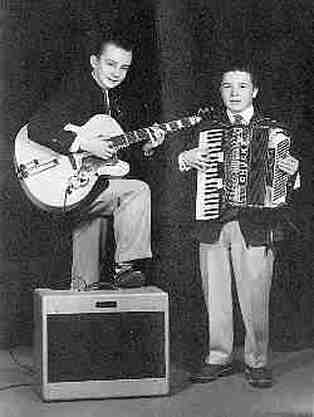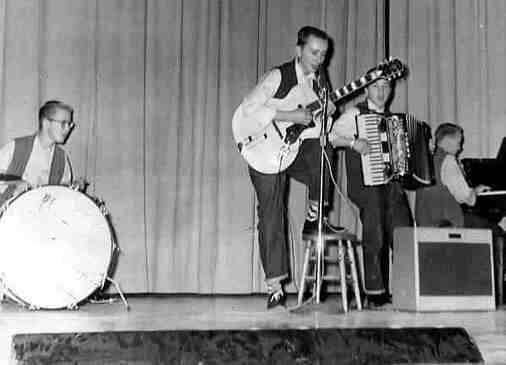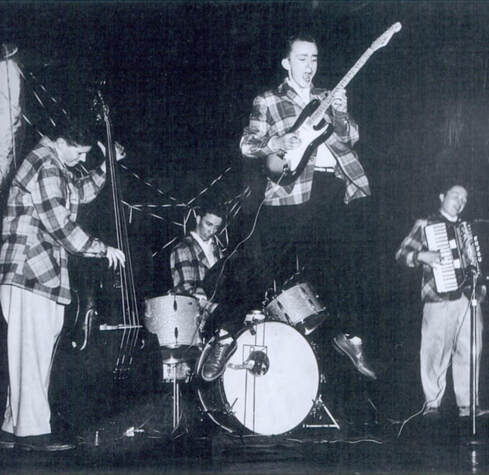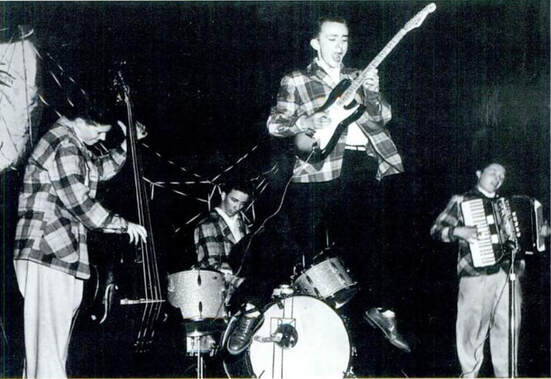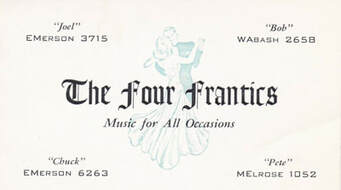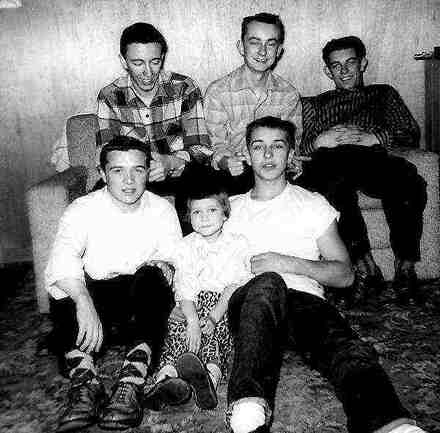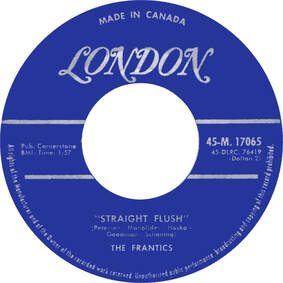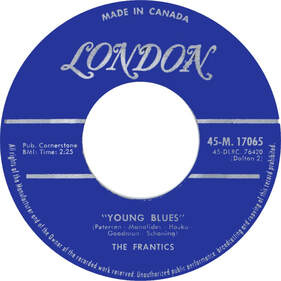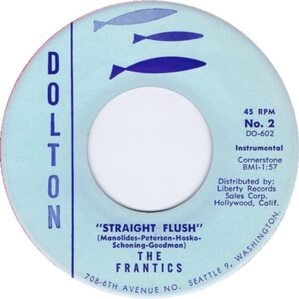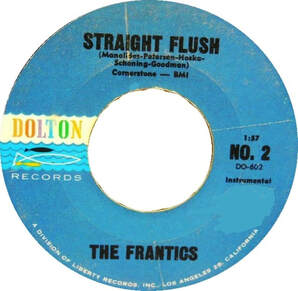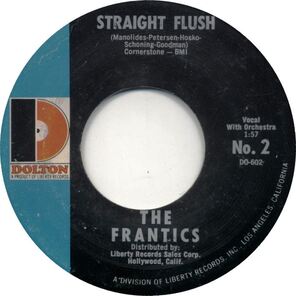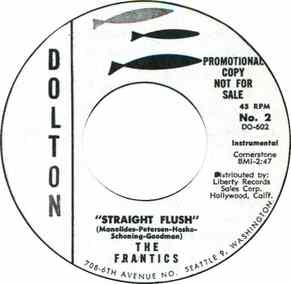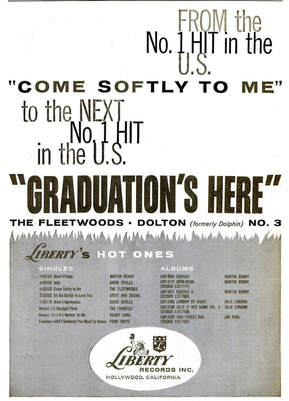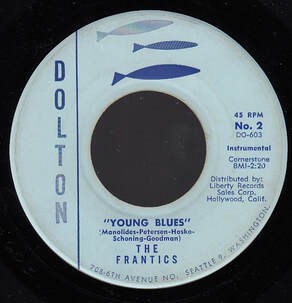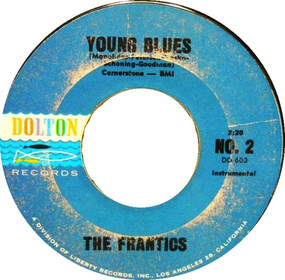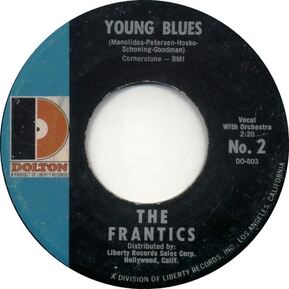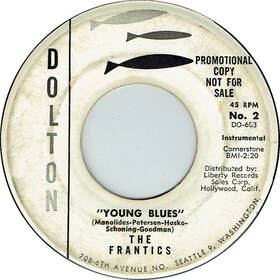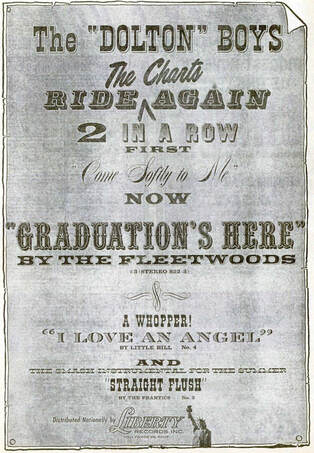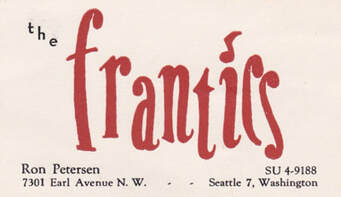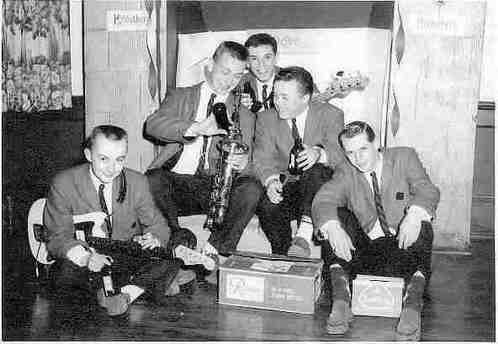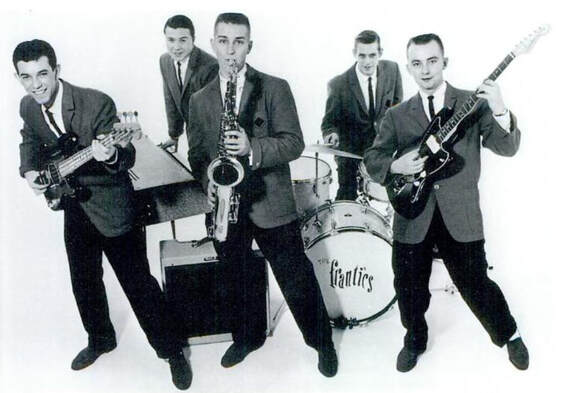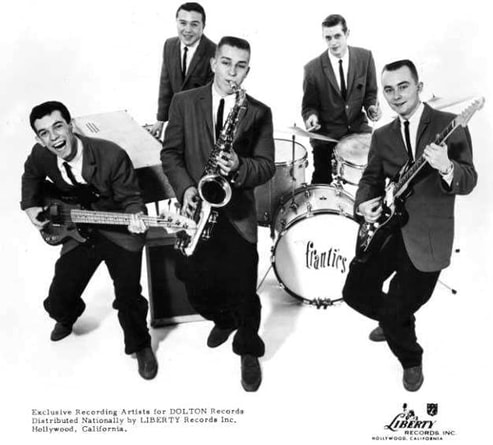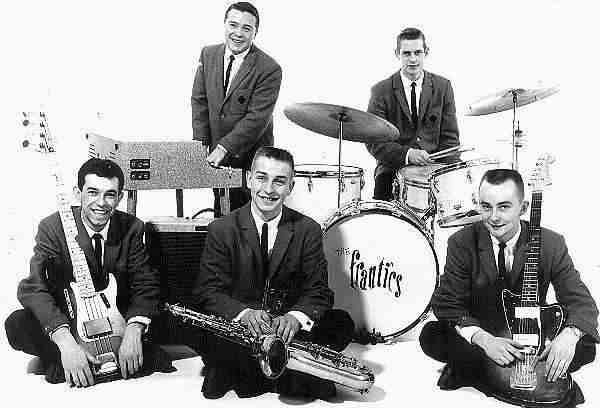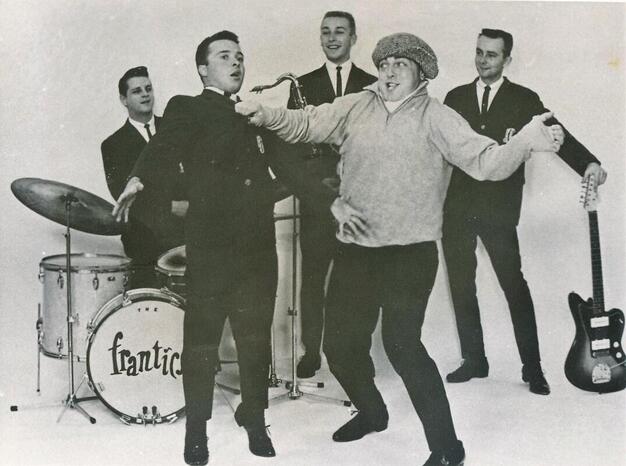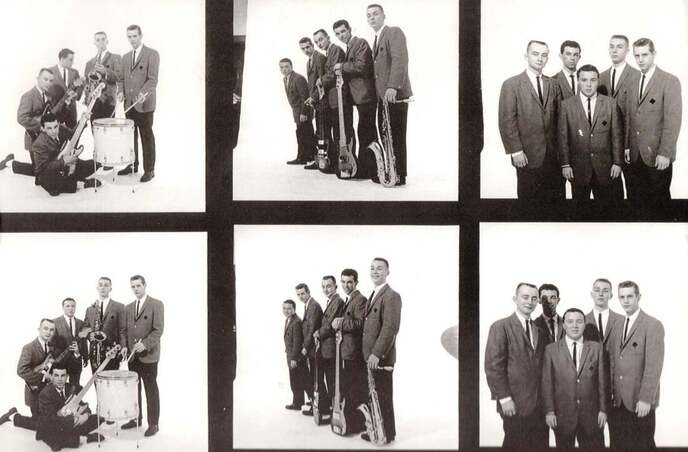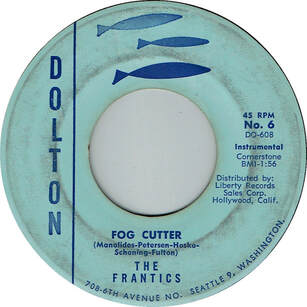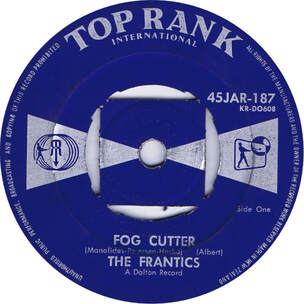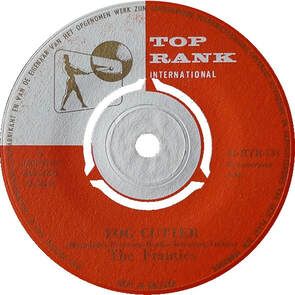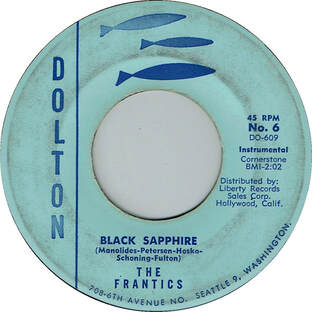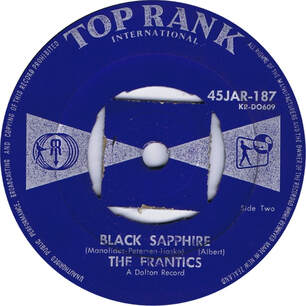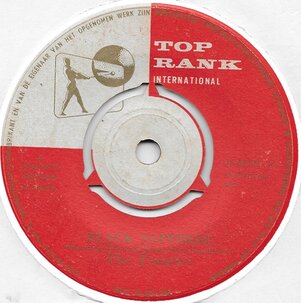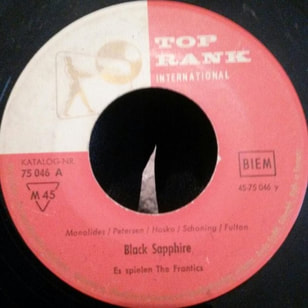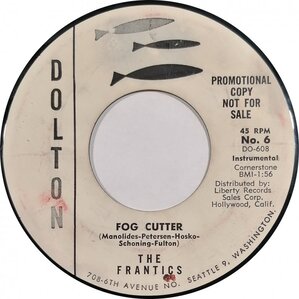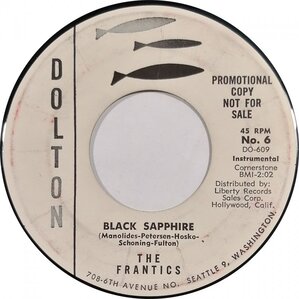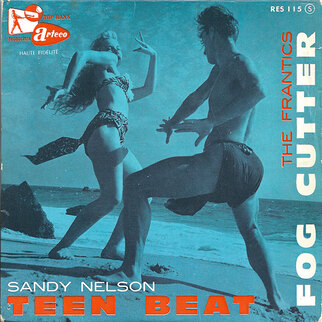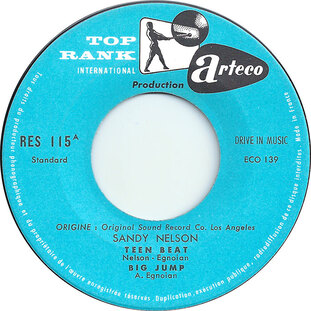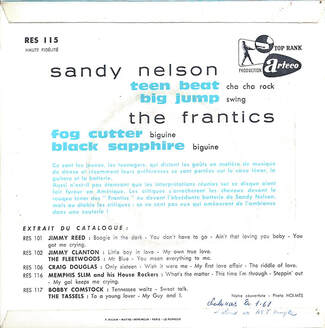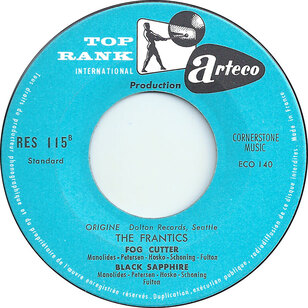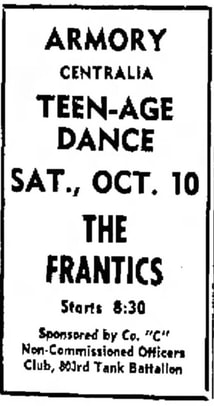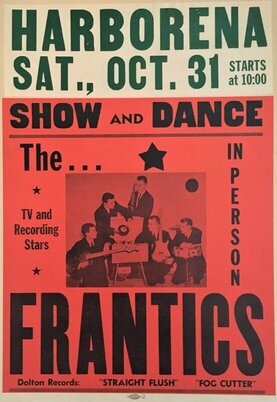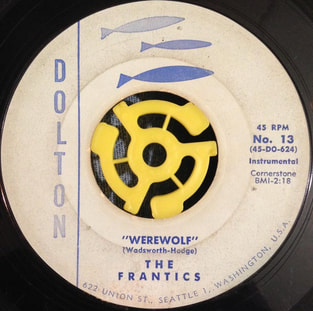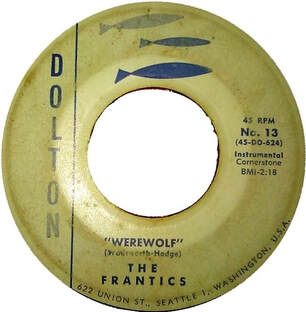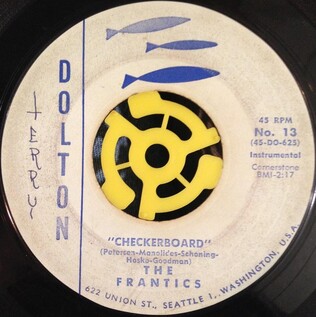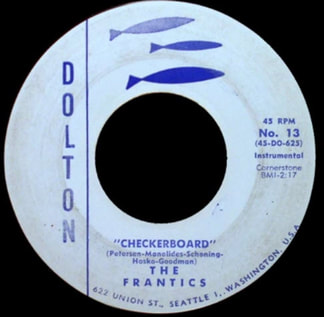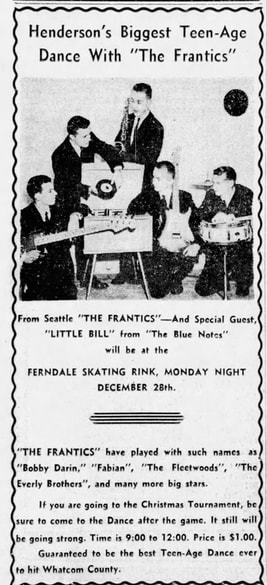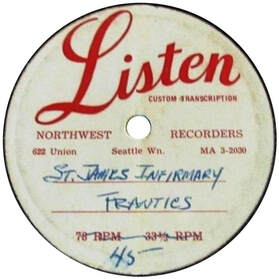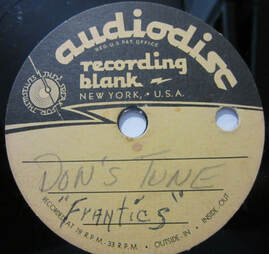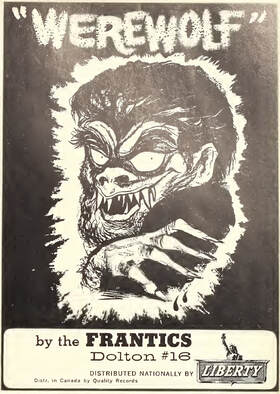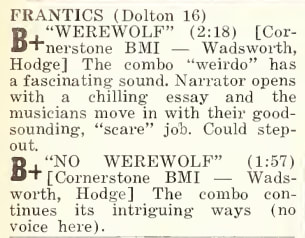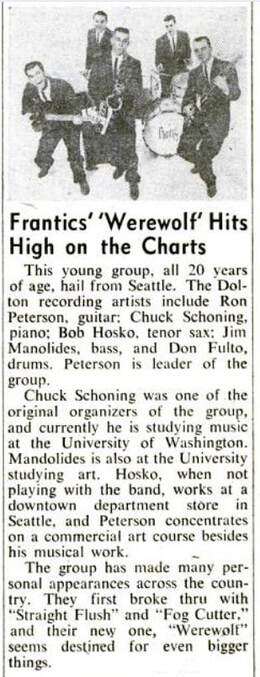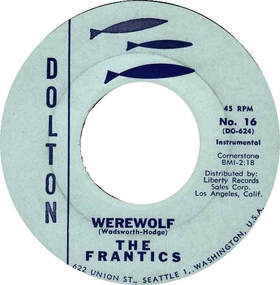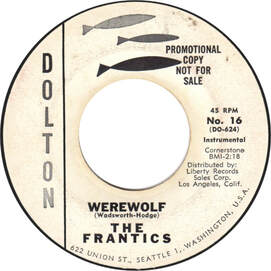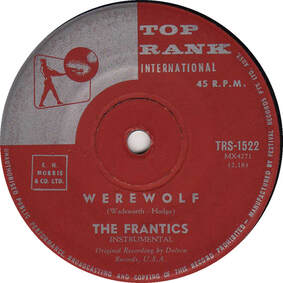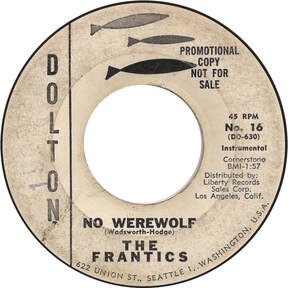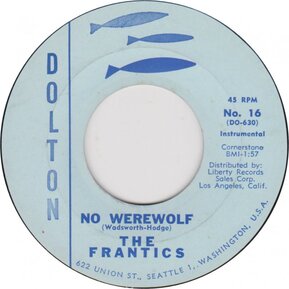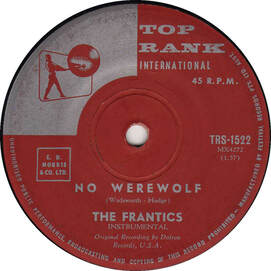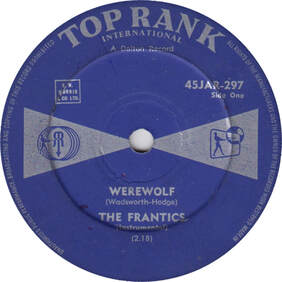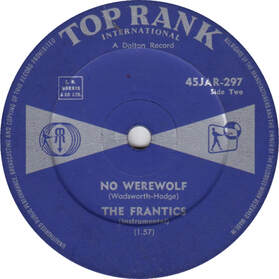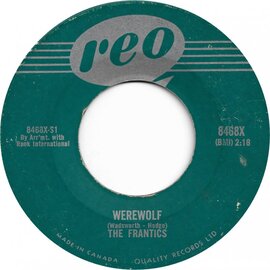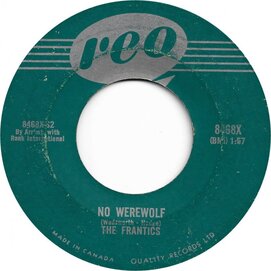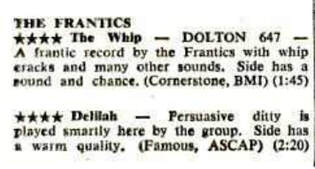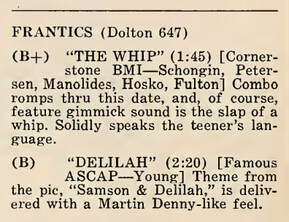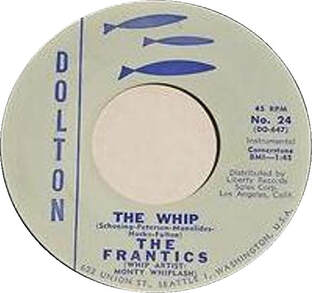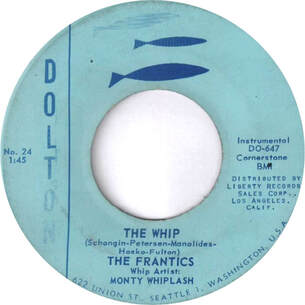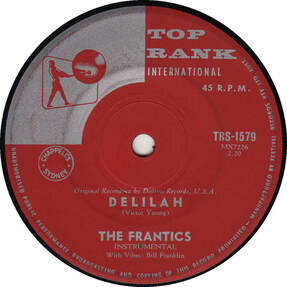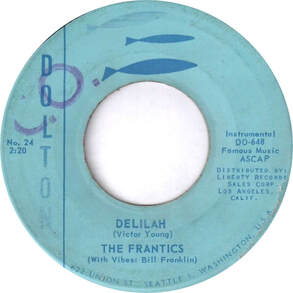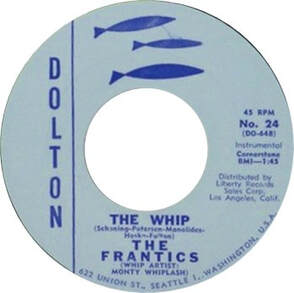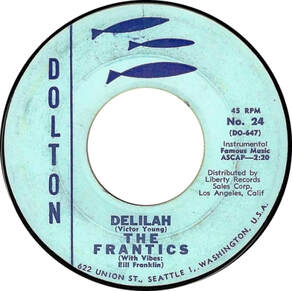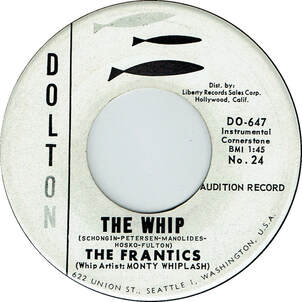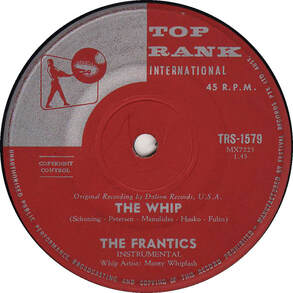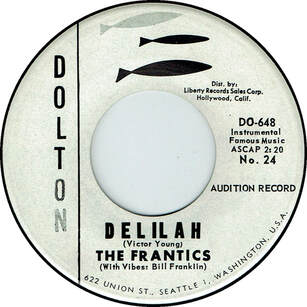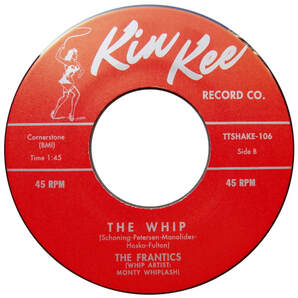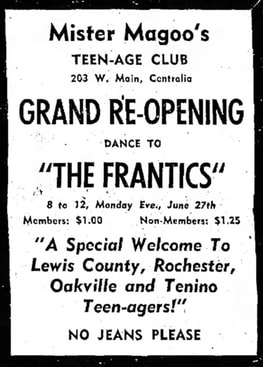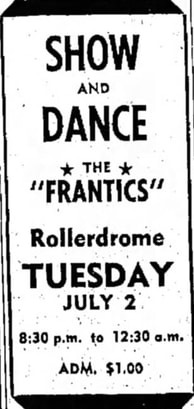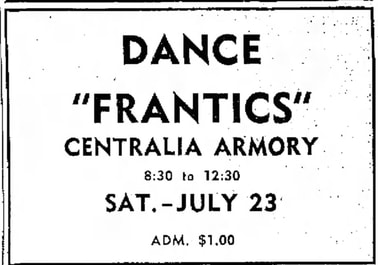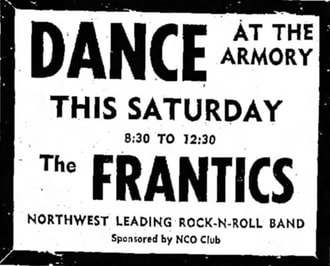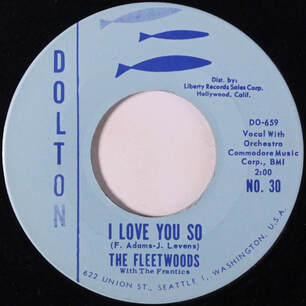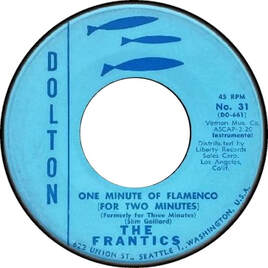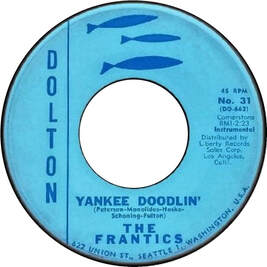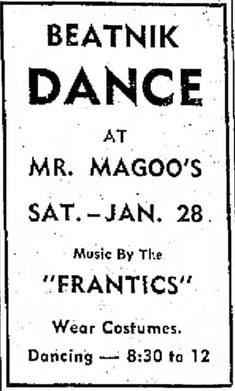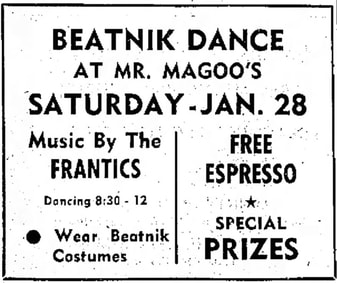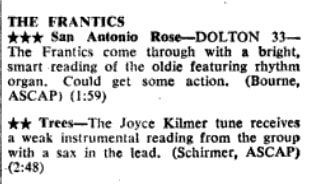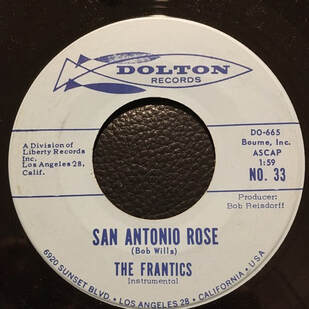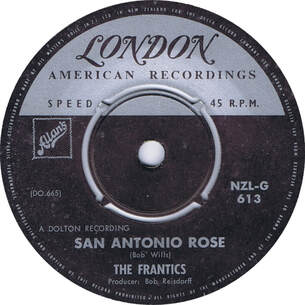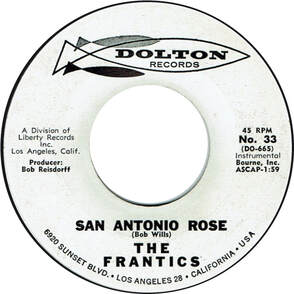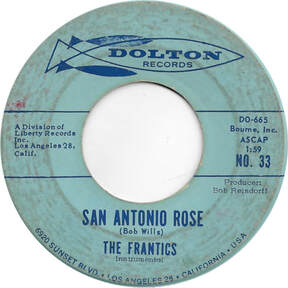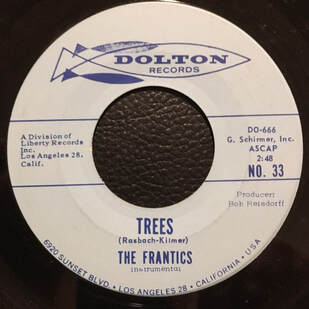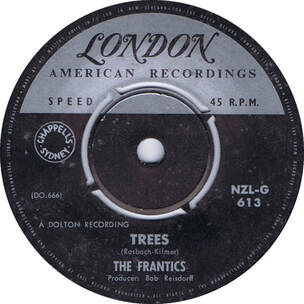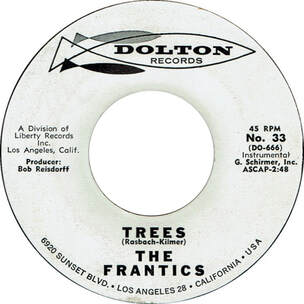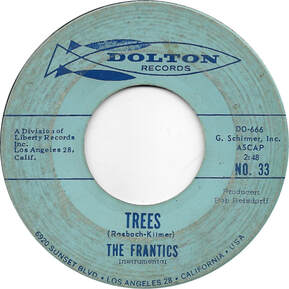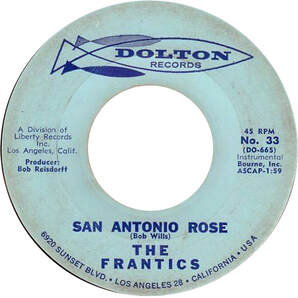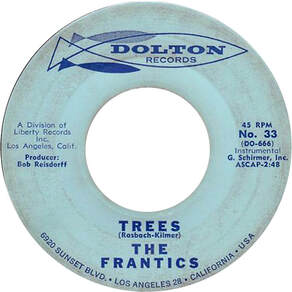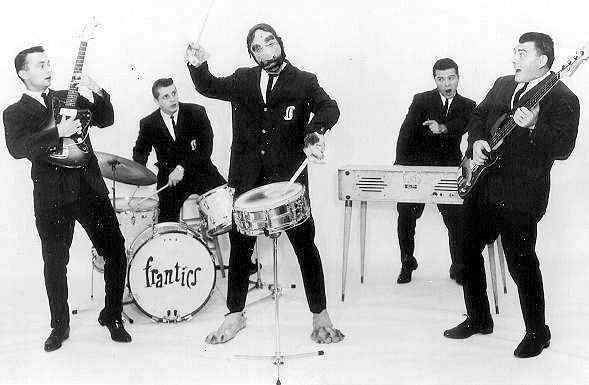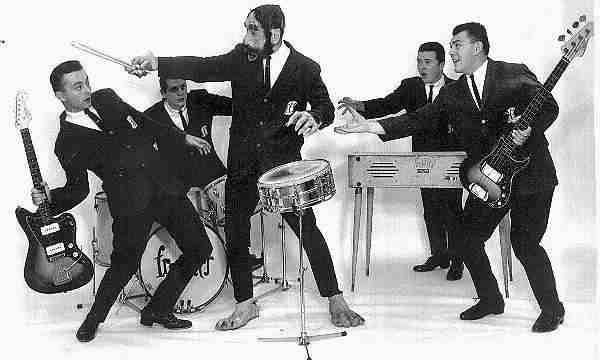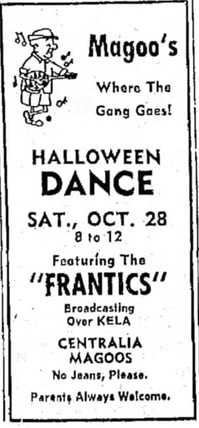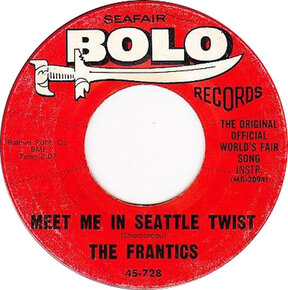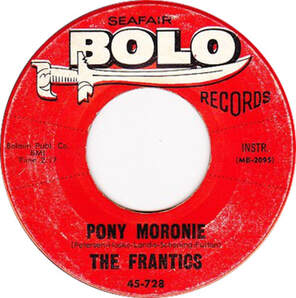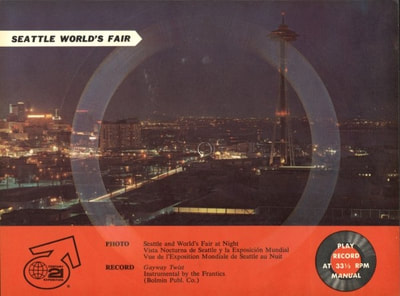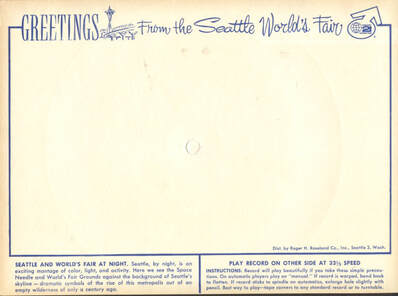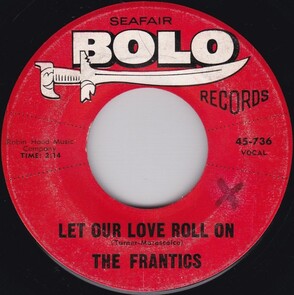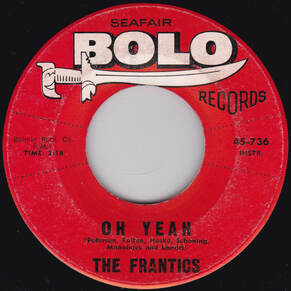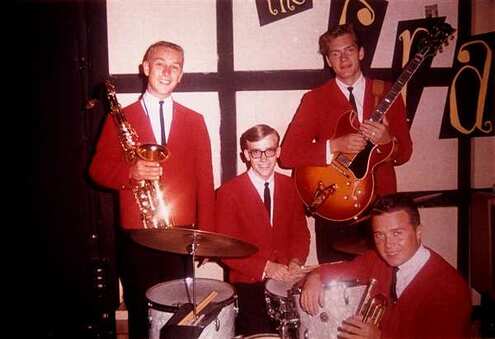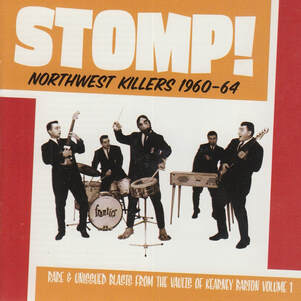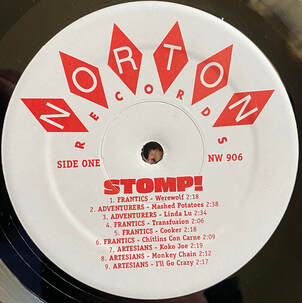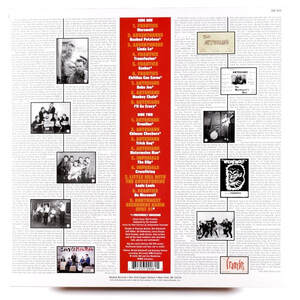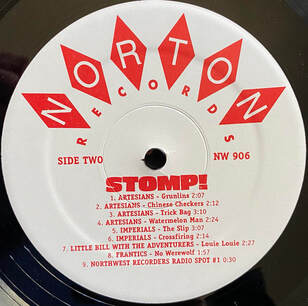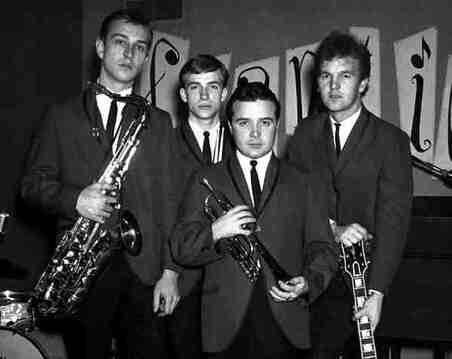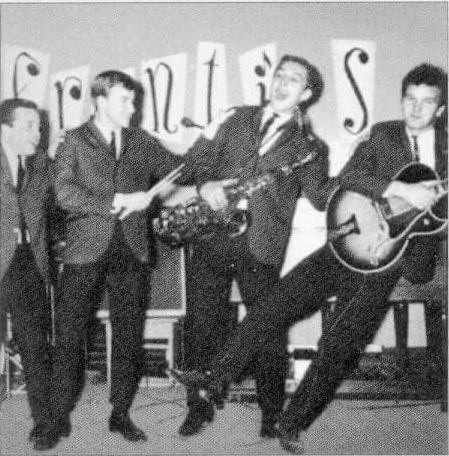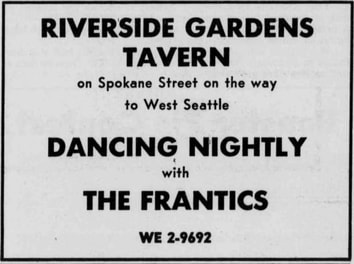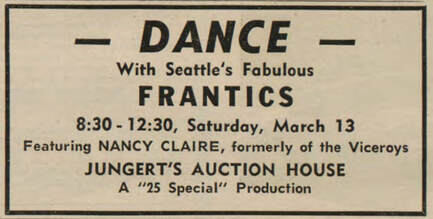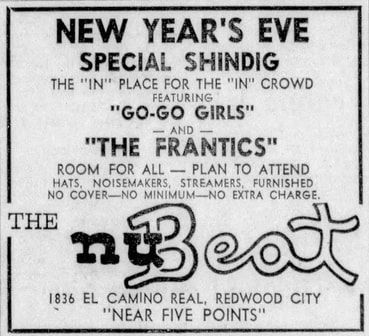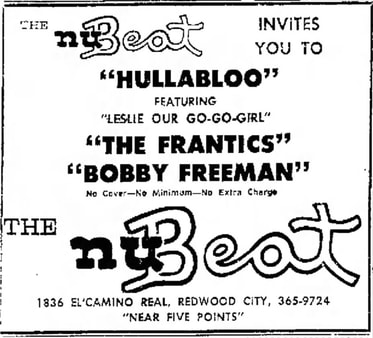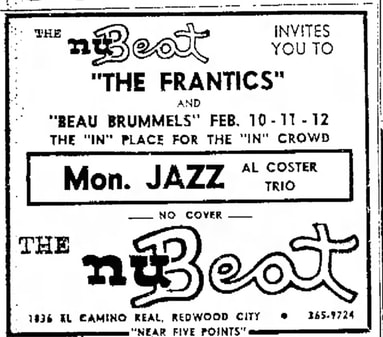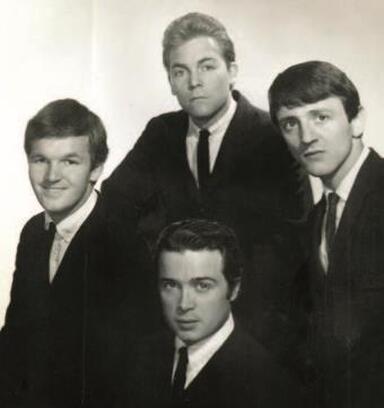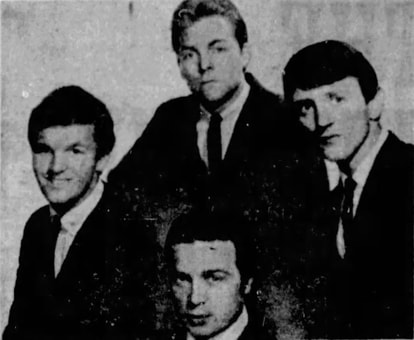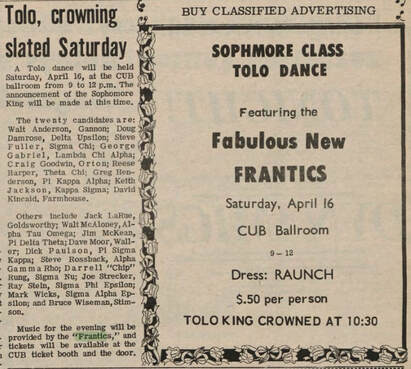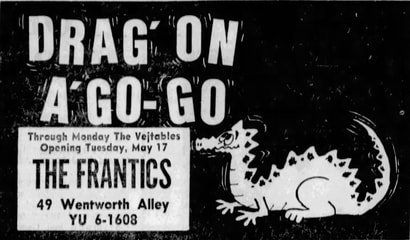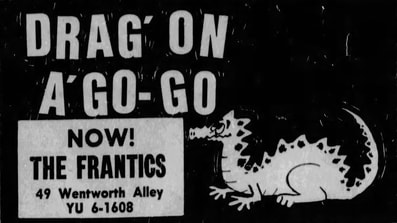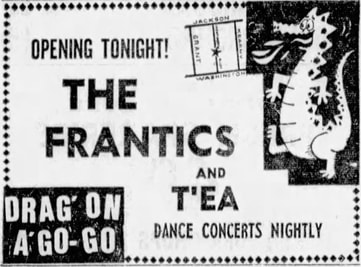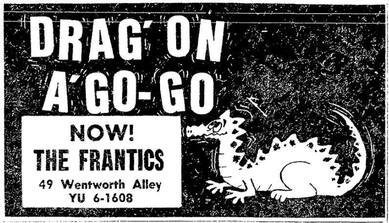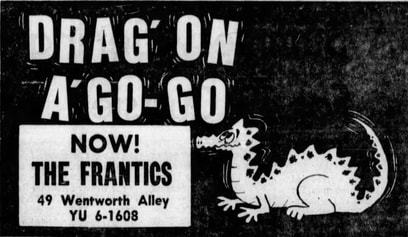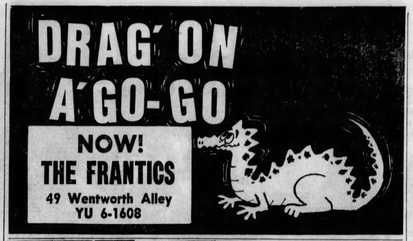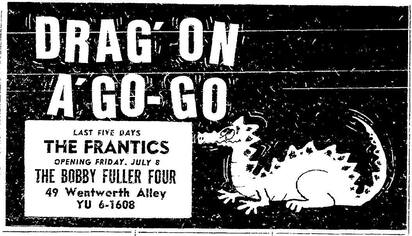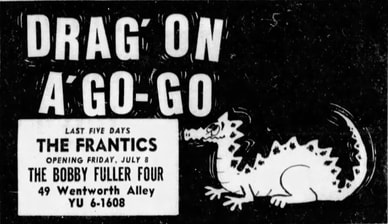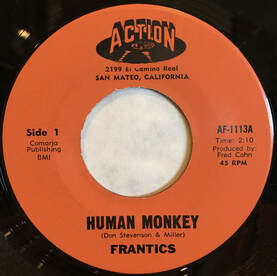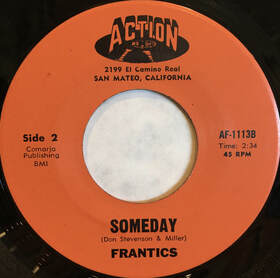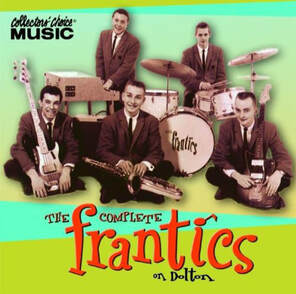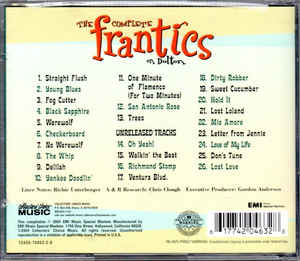If you enjoy what I have put together please consider donating any amount to support and help me to keep this valuable research going. Thanks!!
This day-by-day diary of the Frantics' live, studio, broadcasting, and private activities is the result of three decades of research and interview work by Bruno Ceriotti, but without the significant contributions by other kindred spirits this diary would not have been possible. So, I would like to thank all the people who, in one form or another, contributed to this timeline: Jon Keliehor, Brady Anderson, Jim Manolides (RIP), Ron Petersen, Joel Goodman, Dean Tonkin, Joe Valentine, Peter Blecha, Sam Carlson, Joe Johansen (RIP), Nancy Claire, Doug Bright, Ross Hannan, Corry Arnold, Bob Mosley, Connie Mosley, Cam Cobb, Nick Warburton, Richie Unterberger, Tim Mills, Denise Kaufman, Don Stevenson, Jerry Miller, John Barrett, Paul Dorpat, Peter Kors, Patrick 'The Lama' Lundborg (RIP), Rob Frith, Shindig!, Michael Limnois, Blues.Gr, The Daily Chronicle (Centralia, Washington), Daily Evergreen, Billboard, Cash Box, The Spectator, The Catholic Northwest Progress, and The San Francisco Examiner, The Bellingham Herald, The News Tribune (Tacoma, Washington), Redwood City Tribune, San Mateo Times.
Fall 1952
The story of the Frantics, undoubtedly one of the greatest rock 'n' roll bands emerged from the Pacific Northwest, begins at Jane Addams Junior High School in Seattle, Washington, when 7th grade's schoolmates Ronald Robert Petersen (b. 1940), aka 'Ron', aka 'Pete', and Charles Edward Schoning (b. Tuesday, January 23, 1940, Seattle, King County, Washington - d. Saturday, March 3, 2001, San Rafael, Marin County, California), aka 'Charlie', aka 'Chuck', started playing together at school assemblies as a duo under the name of the Hi-Fi's.
The story of the Frantics, undoubtedly one of the greatest rock 'n' roll bands emerged from the Pacific Northwest, begins at Jane Addams Junior High School in Seattle, Washington, when 7th grade's schoolmates Ronald Robert Petersen (b. 1940), aka 'Ron', aka 'Pete', and Charles Edward Schoning (b. Tuesday, January 23, 1940, Seattle, King County, Washington - d. Saturday, March 3, 2001, San Rafael, Marin County, California), aka 'Charlie', aka 'Chuck', started playing together at school assemblies as a duo under the name of the Hi-Fi's.
THE HI-FI's (FALL 1952 - 1955)
1) Ron Petersen guitar, vocals
2) Charlie Schoning accordion, c-melody sax
1955
After moving from Jane Addams to Lincoln High School, Charlie Schoning and Ron Petersen started a rock 'n' roll band called the Frantics with schoolmates Dean Tonkin on bass, Gary Gerke on piano, and Joseph 'Joe' Valentine (b. 1940) on drums. "The name comes from a popular descriptor of the day, i.e. 'that's real frantic'," recalls Joe Valentine. "We practiced in Gary Gerke's basement because he had a piano." "The idea of a band came out of the movie Blackboard Jungle and the theme music by Bill Haley, 'Rock Around The Clock'," continues Valentine. "That was our first cover tune. Later, we used to sing Hank Ballard's 'Work with Me, Annie' and 'Annie Had a Baby' at school assemblies and thought we were very hip because we knew what they meant."
THE FRANTICS #1 (1955 - 1955 or 1956)
1) Ron Petersen
2) Charlie Schoning
3) Joe Valentine drums
4) Dean Tonkin bass mandolin
5) Gary Gerke piano
1955 or 1956
The Frantics replaced Joe Valentine with another schoolmate drummer named Joel Goodman. "I think that I was asked to join the Frantics because I had a full set of drums and a car that could carry everyone and everything all at once," recalls Joel. "The practice sessions were held in my family's 'rec room' with all the doors wide open. I remember my dad being very proud of our music and the guys in the band. We had a small organ that my dad turned over to Chuck to give us a little fuller sound. We then bought a 'family car' from one of the funeral homes and it was our mode of transportation for all of us and the instruments for awhile. I remember getting all of the different outfits like the plaid jackets and the white 'overhauls'. I had a heck of a time getting the same type of shoe as I was a 13-14 and everyone else was a 8-9. I tried singing once but was asked not to try again."
The Frantics replaced Joe Valentine with another schoolmate drummer named Joel Goodman. "I think that I was asked to join the Frantics because I had a full set of drums and a car that could carry everyone and everything all at once," recalls Joel. "The practice sessions were held in my family's 'rec room' with all the doors wide open. I remember my dad being very proud of our music and the guys in the band. We had a small organ that my dad turned over to Chuck to give us a little fuller sound. We then bought a 'family car' from one of the funeral homes and it was our mode of transportation for all of us and the instruments for awhile. I remember getting all of the different outfits like the plaid jackets and the white 'overhauls'. I had a heck of a time getting the same type of shoe as I was a 13-14 and everyone else was a 8-9. I tried singing once but was asked not to try again."
THE FRANTICS #2 (1955 or 1956 - 1956)
1) Ron Petersen
2) Charlie Schoning
3) Dean Tonkin
4) Gary Gerke
5) Joel Goodman drums
1956
Gary Gerke left the Frantics and at that point Charlie Schoning also started to play electric piano, and the band also became known as the Four Frantics. "Ron, Chuck, and I also performed as the Three Sons playing ballads and jazz," recalls Dean Tonkin. "We used to all pile ourselves and our instruments into Joel Goodman's Pontiac convertible and head for gigs as far away as Spokane. We played Parker's [Ballroom], The Eagles, Trianon Ballroom (once with Hank Ballard and The Midnighters), the Palomar, Spanish Castle, and at the old opera house with the traveling show 'Jazz at the Philharmonic' with Stan Getz, Gene Krupa, Ray Brown and other legends of that time. Since we were non-union, we auditioned for the Ted Mack Amateur Hour one time but lost out to The Dave Lewis Combo (which was eventually disqualified because they were a union band)."
THE FRANTICS #3 (aka THE FOUR FRANTICS) (1956 - 1957)
1) Ron Petersen
2) Charlie Schoning now also on electric piano
3) Dean Tonkin
4) Joel Goodman
Friday, August 24, 1956: 'Battle of Teen-age Bands', Parker's Ballroom, 170th Street and Aurora Avenue North, Seattle, King County, Washington
A so-called 'Battle of Teen-age Bands' was held tonight from 8:00pm to 12 midnight at Parker's Ballroom: The Four Frantics versus The Vocalaires, and Al Capp's Combo versus Dan Richardson Quintet. The show also included performance of Many Guest Artists.
1957
Dean Tonkin left the Frantics. "Over the years," recalls Tonkin, "I have been on the creative side of advertising and marketing and have written, produced, and directed commercial music with such artists as Ray Charles, Stevie Wonder, Jose Feliciano, Larry Carlton, El Chicano, Blood Sweat and Tears, Rojay North, Gloria Jones, Red Rhodes, Hal Blaine, and more." The band replaced him with another schoolmate, a tenor sax player named Robert J. 'Bob' Hosko (b. Friday, September 22, 1939, Washington - d. Wednesday, October 1, 2003, Duvall, King County, Washington). "Bob Hosko joined us after we heard him doing solo's 'jamming' in the lunch room at Lincoln High School and this brought a 'raunchy' sound to our music," recalls Joel Goodman. By the way, after graduated from high school in 1958, Hosko went to work at a downtown department store during the day.
THE FRANTICS #4 (aka THE FOUR FRANTICS) (1957 - DECEMBER 1957 or JANUARY 1958)
1) Ron Petersen
2) Charlie Schoning
3) Joel Goodman
4) Bob Hosko tenor sax
Wednesday, November 27, 1957: 'Silhouettes', Encore Ballroom, 1214 East Pike Street at 13th Avenue, Seattle, King County, Washington
The local Bishop Blanchet High School's Mother's Club sponsored the first all-city Catholic high school dance that night from 9:00pm to 12 midnight, with live music provided by The Four Frantics.
Saturday, November 30, 1957: 'Deep Purple', CYO Etalbo Teen Club, Parish Hall, St. Benedict Church, 1805 N 49th Street, Seattle, King County, Washington
The local St. Benedict's CYO Etalbo Teen Club presented a semi-formal dance (theme was 'Deep Purple') that night in the Parish Hall from 8:30pm to 11:30pm, with live music provided by The Four Frantics.
Friday, December 13, 1957: 'CYO Teen Club Dance', K. of C. (Knights of Columbus) Hall, 722 East Union Street, Seattle, King County, Washington
The band was advertised as The Four Frantics.
December 1957 or January 1958
The Four Frantics became The Five Frantics with the addition of a new bass player named James Evans 'Jim' Manolides (b. Tuesday, March 19, 1940, Seattle - d. Monday, May 9, 2016, Hoquiam, Grays Harbor County, Washington, for a stroke).
THE FRANTICS #5 (aka THE FIVE FRANTICS) (DECEMBER 1957 or JANUARY 1958 - JUNE 1959 (?))
1) Ron Petersen
2) Charlie Schoning
3) Joel Goodman
4) Bob Hosko
5) Jim Manolides bass, vocals
Friday, January 31, 1958: 'CYO Teen Club Dance', K. of C. (Knights of Columbus) Hall, 722 East Union Street, Seattle, King County, Washington
The Five Frantics played from 8:30pm to 11:30pm.
Friday, February 15, 1958: 'Half-a-Heart', CYO Etalbo Teen Club, Parochial School Hall, St. Benedict Church, 1805 N 49th Street, Seattle, King County, Washington
The local St. Benedict's CYO Etalbo Teen Club presented a dance (theme was 'Half-a-Heart') that night in the Parochial School Hall from 8:30pm to 11:30pm, with live music provided by The Five Frantics.
Wednesday, November 26, 1958: Encore Ballroom, 1214 East Pike Street at 13th Avenue, Seattle, King County, Washington
The local Bishop Blanchet High School's student body and school's Mother's Club co-sponsored an all-city Catholic high school dance that night from 9:00pm to 12 midnight, with live music provided by The Frantics.
November 1958 (?)
One evening, after a rehearsal and apparently on a collective whim, the Frantics loaded their gear into a couple of cars and drove to the downtown studios of KOL radio. They waved at the DJ, Art Simpson, through a window and then, before they knew it, they were inside the station’s small studio recording. That same night Simpson began broadcasting their original instrumental, 'Checkerboard.' In fact the DJ was impressed enough to send them over to meet the late Bob Reisdorff, co-owner of a new local label called Dolton Records. The label, whose logo/graphics was designed by Jim Manolides who was an art student at the time, had just signed a teen vocal trio called the Fleetwoods, and the Frantics was eventually the second act signed by Reisdorff and his partner Bonnie Guitar.
December 1958 (?): Joe Boles Custom Recorders, 3550 SW Admiral Way, West Seattle, King County, Washington
Shortly after signed a deal with Dolton Records, "we made our first recording in a basement recording studio in West Seattle," recalls Joel Goodman. "We were introduced to the Fleetwoods there and we made their first cut of [their debut single] 'Come Softly To Me' at that time (they then went to California for the recording that we all know and love)."
Sunday, February 22, 1959: Parker's Ballroom, 170th Street and Aurora Avenue North, Seattle, King County, Washington
The Frantics and their labelmate the Fleetwoods both performed as opening acts for a visiting star, singer Bobby Darin. Actually the Frantics were also hired to play with Darin who came out west without a backing band. "We got this job at Parker's on a Sunday night," recalls Jim Manolides. "We knew for several weeks that we got this big gig coming so we already knew his [hit] songs - 'Splish Splash', 'Plain Jane,' 'Queen Of The Hop' - but in this case we learned both sides of all his records! So, he brings his own piano player with him, Dick Berke, and we play Parker's. He loved it! He was just thrilled! The place was packed! There were 1200 people. And after he does his little show he came and joined the band! He sang Ray Charles' 'I've Got A Woman' with us and then he started playin' the piano a little bit and he was singin' - and playin' the drums! He just loved it and had a really good time."
Monday, February 23, 1959: Joe Boles Custom Recorders, 3550 SW Admiral Way, West Seattle, King County, Washington
Bobby Darin was impressed enough with the Frantics that he asked them to back him on some recordings the next day. The session was held in the morning at the late sound engineer Jay F. 'Joe' Boles' home that featured a large basement room in which he set up a recording studio. Darin showed up with charts and lyrics for two songs he'd recently written: 'Dream Lover' and 'Bullmoose'. After a successful, amiable three hours session, each player was paid $90, thanked, and then Darin and the band parted ways. A month and a half later, in early April 1959, Darin released both songs on his latest single although his label, Atco, demanded they be re-recorded using professional studio musicians, so the early demo versions recorded with the Frantics remained unissued.
Friday, April 10, 1959: 'CYO Teen Club Dance', K. of C. (Knights of Columbus) Hall, 722 East Union Street, Seattle, King County, Washington
The Frantics played from 8:30pm to 11:30pm.
Friday, April 17, 1959: Senator Ballroom, Eagles Auditorium Building, 1416 7th Avenue at Union Street, Seattle, King County, Washington
The local Bishop Blanchet High School's student council and school's Mother's Club co-sponsored an all-city Catholic high school dance that night from 9:00pm to 12 midnight, with live music provided by The Frantics.
April 1959: Encore Ballroom, 1214 East Pike Street at 13th Avenue, Seattle, King County, Washington
Also on the bill: The Playboys.
May ?, 1959
The Frantics' debut single, 'Straight Flush / Young Blues' (Dolton No. 2), was released in the US. Both songs were recorded at Joe Boles Custom Recorders and written by all the five members of the band. The single, which proved to be a Top-10 regional seller that Dolton pushed nationally where it reached #91 in the Billboard Hot 100 single chart, was also released in Canada in June 1959, and apparently also in the UK that same year. The single was also reissued in the US in 1962.
June 1959 (?)
Joel Goodman left the Frantics (he retired from music and went into real estate) and was replaced by a new drummer, the late Don Fulton.
THE FRANTICS #6 (JUNE 1959 (?) - SPRING or SUMMER 1961)
1) Ron Petersen
2) Charlie Schoning
3) Jim Manolides
4) Bob Hosko
5) Don Fulton drums
+
6) Nancy Claire vocals (she sang with them live from time to time since early 1960)
Late July 1959
The Frantics' second single, 'Fog Cutter / Black Sapphire' (Dolton No. 6), was released in the US. Both songs were recorded at Joe Boles Custom Recorders and written by all the five members of the band. The disc, which reached #93 in the Billboard Hot 100 single chart, was also released later that same year in Netherlands (November), Germany (December), and New Zealand. Also, in December 1959, both songs were released on the flipside of a French extend play with Sandy Nelson's 'Teen Beat' and 'Big Jump' on the A side.
Sunday, September 13, 1959: Northwest Recorders, 622 Union Street, Seattle, King County, Washington
The Frantics headed into the late engineer Kearney Barton's Northwest Recorders and lay down a couple of tracks, ‘Werewolf’ and ‘Cuban Vacation.’ ‘Werewolf’, which was written by Terry Wadsworth & Gary Hodge (two local singers and songwriters) and which was released as the topside of their third single a couple of months later, was an offbeat soundscape that opens with a bit of dialogue from Lon Chaney Jr.'s film The Wolf Man (1941). “The poem at the beginning is the voice of Bob Reisdorff, the wolf howls are Kearney Barton, and the scream at the end is Bonnie Guitar, and there you have the truth,” points out Jimmy Manolides in 2012. Instead, ‘Cuban Vacation’ remained unissued.
Saturday, October 10, 1959: 'Teen-Age Dance', Centralia National Guard Armory, 309 Byrd Street, Centralia, Lewis County, Washington
The show, which started at 8:30pm, was sponsored by Co. 'C'.
Saturday, October 31, 1959: 'Show and Dance', Harborena (Roller Skating Rink), 2112 Simpson Avenue, Hoquiam, Harbor County, Washington
One show, started at 10:00pm.
Friday, November 6, 1959: Civic Auditorium, 321 Mercer Sreet, Seattle, King County, Washington
Also on the bill: 'Little Bill' Engelhart, The Playboys, Johnny Millward. One show, started at 8:00pm.
November 1959
The Frantics' third single, 'Werewolf / Checkerboard' (Dolton No. 13), was released only in the US. The flipside was recorded at the late engineer Kearney Barton's Northwest Recorders, and was a rocker written by the band several months earlier when Joel Goodman was still with them.
Monday, December 28, 1959: ‘Henderson’s Biggest Teen-Age Dance,’ Roller-Arena (aka Ferndale Skating Rink), Pioneer Park, Ferndale, Whatcom County, Washington
The show lasted from 9pm to 12 midnight. Also on the bill: Little Bill from The Blue Notes.
1959/60: Northwest Recorders, 622 Union Street, Seattle, King County, Washington
The Frantics headed into the late engineer Kearney Barton's Northwest Recorders and lay down a cover of an old blues song titled 'St. James Infirmary'. The recording remained unissued and was only pressed into a one side 45 rpm acetate that Ron Petersen kept in his house for all these years.
1959/60: Northwest Recorders (?), 622 Union Street, Seattle, King County, Washington
Supposedly again at Kearney Barton's Northwest Recorders, the Frantics recorded a song titled 'Don's Tune', which may have referred to their drummer Don Fulton. The recording remained unissued and was only pressed into a one side 33 1/3 rpm acetate. However, the band recorded another version of that song a year or so later in Hollywood and that one later surfaced on their compilation CD, 'The Complete Frantics on Dolton'.
1960: unknown recording studio, Hollywood, Los Angeles County, California
The Frantics recorded several tracks and most of them remained unissued until 2004 when they surfaced on the CD compilation, 'The Complete Frantics on Dolton'.
Early 1960
The Frantics, who until then had been essentially an instrumental combo, began to hired, from time to time for their gigs, the most in-demand female singer in the area, Nancy Claire (b. Nancy Claire Penninger, Monday, August 2, 1943, Seattle), aka "Northwest Rock 'n' Roll First Lady". She first met them at a Tacoma TV show and they ended up hiring her for some gigs exactly.
Thursday, January 28, 1960
The Frantics backed up (uncredited) a vocal duo called Stan and Mike on their first and only single, 'Call Of The Wild / Baby Me' (Topaz Records 31691/31692), which was released only in the US. The disc was recorded at Kearney Barton's Northwest Recorders.
February ?, 1960
The Frantics' fourth single, 'Werewolf / No Werewolf' (Dolton No. 16), was released in the US. The disc was a re-release of 'Werewolf' with a new song on the flipside titled 'No Werewolf' which was actually the A side without the wolf howls. "This record reached #83 with a bullet in its second week on the charts," recalled Jimmy Manolides in 2012. The single was also released later that same year in Canada, New Zealand, Australia, and Japan (August). By the way, after 'Werewolf' became a minor hit that winter, Bob Hosko used to put on a wolf mask and dancing around while playing sax during their gigs!
Saturday, February 6, 1960: ‘Basketball Game and Dance’, Tacoma Armory, 1001 South Yakima Avenue, Tacoma, Pierce County, Washington
The show lasted from 8pm to 12 midnight. Also on the bill: The Wailers.
March 1960: Youth Activity Center (aka Teen Center), Fort Lewis (US military facility), south-southwest of Tacoma, Pierce County, Washington
Nancy Claire sang with the Frantics tonight.
Late June 1960
The Frantics' fifth single, 'The Whip / Delilah' (Dolton No. 24), was released in the US. The A side was written by all the five members of the band, while the flipside was written by Victor Young. The single, which was recorded at Kearney Barton's Northwest Recorders with Bill Franklin as guest on vibes on the flipside, was also released in Australia later that year. 'The Whip' was also released in 2012 in the UK as flipside of a single with another song of the same name recorded by The Originals on the A side.
Monday, June 27, 1960: 'Grand Re-Opening Dance', Mister Magoo's Teen-Age Club, 203 West Main Street, Centralia, Lewis County, Washington
The show lasted from 8:00pm to 12 midnight.
Tuesday, July 12, 1960: 'Show And Dance', Rollerdrome, 216 West Maple Street, Centralia, Lewis County, Washington
The show lasted from 8:30pm to 12:30am.
Saturday, July 23, 1960: ‘Dance,’ Centralia National Guard Armory, 309 Byrd Street, Centralia, Lewis County, Washington
The show lasted from 8:30pm to 12:30am.
August 1960
The Frantics backed up (uncredited) a rhythm 'n' blues vocal quartet called Four Pearls on the flipside of their single, 'Look At Me / It's Almost Tomorrow' (Dolton No. 26), which was released that month only in the US. The disc was recorded at Kearney Barton's Northwest Recorders.
Saturday, September 24, 1960: 'Dance', Centralia National Guard Armory, 309 Byrd Street, Centralia, Lewis County, Washington
The show, which lasted from 8:30pm to 12:30am, was sponsored by NCO Club.
November ?, 1960
The Frantics backed up (credited) the Fleetwoods on the flipside of their latest single, 'Confidential / I Love You So' (Dolton No. 30), which was released in the US and Canada that month. The disc was recorded at Kearney Barton's Northwest Recorders.
Wednesday, November 16, 1960
The Frantics' sixth single, 'One Minute Of Flamenco (For Two Minutes) (Formerly For Three Minutes) / Yankee Doodlin'' (Dolton No. 31), was released only in the US. The disc was recorded at Kearney Barton's Northwest Recorders. The A side was written by Slim Gaillard, while the flipside was written by all the five members of the band.
Saturday, December 31, 1960: 'Battle of the Bands', Birdland, 2203 E Madison Street, Seattle, King County, Washington
A so-called "Battle of the Bands" was held at the Birdland on New Year's Eve and the combatants that night included a number of up-and-coming bands, mostly black, yet with one white group, i.e. the Frantics (with Nancy Claire). "Birdland was open from like 11:30 ‘till 3:30 in the morning. After hours. All black clientele, except for some young white musicians that would go in to hear the band… and it was a neat place!," recalled Jim Manolides. "It was centrally located at the edge of the black district, so you had a lot of black music going on there. It was a big hall, not fancy, but the music was louder there than any other place."
Friday, January 20, 1961: 'Sitzmark Stomp', Chieftain Cafeteria, Seattle University campus, Seattle, King County, Washington
The Frantics provided live music from 9:30pm to 12:30am, during a 'Sitzmark Stomp' dance sponsored by Seattle University's Ski Club (a "sitzmark" is the hole in the snow made by a skier who takes a spill).
Saturday, January 28, 1961: 'Beatnik Dance', Mister Magoo's Teen-Age Club, 203 West Main Street, Centralia, Lewis County, Washington
The show lasted from 8:30pm to 12 midnight.
February ?, 1961
The Frantics' seventh single, 'San Antonio Rose / Trees' (Dolton No. 33), was released in the US. The A side was written by Bob Wills, while the flipside was written by Rasbach & Kilmer. The disc, which was produced by Bob Reisdorff and maybe recorded in Hollywood in 1960, was also released in New Zealand in May 1961.
Tuesday, February 14, 1961: 'Valentine's Day Dance', Youth Activity Center (aka Teen Center), Fort Lewis (US military facility), south-southwest of Tacoma, Pierce County, Washington
March - ? (month unknown) 1961: Dave's Fifth Avenue, 112 5th Avenue North, downtown Seattle, King County, Washington
In March '61, the Frantics started to play at Dave's Fifth Avenue six nights a week (Monday to Saturday) from 9:00pm to 2:00am. Nancy Claire also sang with the band there sometime, although as she later recalled, because she was underage and so she couldn't get into a nightclub, "they had to pass a mic to me out in the alley."
Spring or Summer 1961
Jim Manolides left the band (he went to play with Dave Lewis Trio, The Counts, The Dynamics, James Henry and The Olympics, Jr. Cadillac, Sweet Talkin Jones, and many others) and was replaced by a new bass player named Jeno Landis (b. 1942, Seattle - d. 2016, Las Vegas, Clark County, Nevada).
THE FRANTICS #7 (SPRING or SUMMER 1961 - DECEMBER 1962 (?))
1) Ron Petersen
2) Charlie Schoning
3) Bob Hosko
4) Don Fulton
5) Jeno Landis bass
+
6) Nancy Claire
? - ? (months unknown) 1961: Dave's Fifth Avenue, 112 5th Avenue North, downtown Seattle, King County, Washington
The Frantics continued to play at Dave's Fifth Avenue six nights a week (Monday to Saturday) from 9:00pm to 2:00am.
Summer 1961: unknown recording studio, Hollywood, Los Angeles County, California
The Frantics recorded several tracks and most of them remained unissued until 2004 when they surfaced on the CD compilation, 'The Complete Frantics on Dolton'.
Wednesday, October 25, 1961
The Frantics backed up (uncredited) an all-girl vocal group called the Good Sisters on their first and only single, 'Teenager's Plea / Do You Mean What You Say' (Hitt Records 45-0001), which was released that day only in Canada. Although released for a local label based in Vancouver, Canada, both songs were recorded at Joe Boles Custom Recorders in West Seattle, and produced by Seafair Bolo Records, another Seattle-based label which had recently signed the Frantics after they left Dolton.
Saturday, October 28, 1961: 'Halloween Dance', Mister Magoo's Teen-Age Club, 203 West Main Street, Centralia, Lewis County, Washington
The show, which lasted from 8:00pm to 12 midnight, was broadcasted live on KELA, a local commercial AM radio station.
Friday, November 24, 1961: '8th Annual Convention of CYO Teen Club', Grand Ballroom, Olympic Hotel, 411 University Street, Seattle, King County, Washington
The Frantics and The Dynamics provided music entertainment during a convention mixer which lasted from 9:30pm to 12:30am.
1961: Crescent Ballroom, 1308-1310 Fawcett Avenue at South 13th Street, downtown Tacoma, Pierce County, Washington
The Frantics with Nancy Claire played as opening act for a teen singer, one between Kenny O'Dell or Shane (no one remember), who had came up from Los Angeles to play some local teen-dances to promote his new single.
1961
Inspired by Les Paul's overdubbing work, Ron Petersen recorded a couple of tracks where he overdubbed every instrument and then released them as a single, 'Forgotten Love / Lover' (Seafair Bolo Records 45-724), under the name of The Tru-Sonics. The A side was penned by Ron, while the flipside was penned by Rodgers & Hart.
Sunday, February 25, 1962
The Frantics' eighth single, 'Meet Me In Seattle Twist / Pony Moronie' (Seafair Bolo 45-728), was released only in the US. The A side was written by Chambreau and was chosen as "The Original Official World's Fair Song" to promote the Seattle World's Fair when it opened a couple of months later, while the flipside was written by all the five members of the band.
Monday, April 9 - Saturday, April 14, 1962: Dave's Fifth Avenue, 112 5th Avenue N, downtown Seattle, King County, Washington
Monday, April 16 - Saturday, April 21, 1962: Dave's Fifth Avenue, 112 5th Avenue N, downtown Seattle, King County, Washington
Monday, April 23 - Saturday, April 28, 1962: Dave's Fifth Avenue, 112 5th Avenue N, downtown Seattle, King County, Washington
When the Seattle World's Fair opened in late April '62, the Frantics were playing six nights a week (Monday to Saturday) from 9:00pm to 2:00am at Dave's Fifth Avenue just few streets away from the site of the fair. A lot of Fair attenders flocked to the club to hear the band play 'Meet Me In Seattle Twist', the original official world's fair song, and also another Fair-oriented song titled 'Gayway Twist'. By the way, unaware by the Frantics and vice versa, their future drummer Jon Keliehor was parading around in a World's Fair band uniform on a daily basis, playing drums in Jackie Souder's World's Fair Band.
Monday, April 30 - Saturday, May 5, 1962: Dave's Fifth Avenue, 112 5th Avenue N, downtown Seattle, King County, Washington
Monday, May 7 - Saturday, May 12, 1962: Dave's Fifth Avenue, 112 5th Avenue N, downtown Seattle, King County, Washington
Monday, May 14 - Saturday, May 19, 1962: Dave's Fifth Avenue, 112 5th Avenue N, downtown Seattle, King County, Washington
Monday, May 21 - Saturday, May 26, 1962: Dave's Fifth Avenue, 112 5th Avenue N, downtown Seattle, King County, Washington
Monday, May 28 - Saturday, June 2, 1962: Dave's Fifth Avenue, 112 5th Avenue N, downtown Seattle, King County, Washington
Monday, June 4 - Saturday, June 9, 1962: Dave's Fifth Avenue, 112 5th Avenue N, downtown Seattle, King County, Washington
Monday, June 11 - Saturday, June 16, 1962: Dave's Fifth Avenue, 112 5th Avenue N, downtown Seattle, King County, Washington
Monday, June 18 - Saturday, June 23, 1962: Dave's Fifth Avenue, 112 5th Avenue N, downtown Seattle, King County, Washington
Monday, June 25 - Saturday, June 30, 1962: Dave's Fifth Avenue, 112 5th Avenue N, downtown Seattle, King County, Washington
Monday, July 2 - Saturday, July 7, 1962: Dave's Fifth Avenue, 112 5th Avenue N, downtown Seattle, King County, Washington
Monday, July 9 - Saturday, July 14, 1962: Dave's Fifth Avenue, 112 5th Avenue N, downtown Seattle, King County, Washington
Monday, July 16 - Saturday, July 21, 1962: Dave's Fifth Avenue, 112 5th Avenue N, downtown Seattle, King County, Washington
Monday, July 23 - Saturday, July 28, 1962: Dave's Fifth Avenue, 112 5th Avenue N, downtown Seattle, King County, Washington
Monday, July 30 - Saturday, August 4, 1962: Dave's Fifth Avenue, 112 5th Avenue N, downtown Seattle, King County, Washington
Monday, August 6 - Saturday, August 11, 1962: Dave's Fifth Avenue, 112 5th Avenue N, downtown Seattle, King County, Washington
Monday, August 13 - Saturday, August 18, 1962: Dave's Fifth Avenue, 112 5th Avenue N, downtown Seattle, King County, Washington
Monday, August 20 - Saturday, August 25, 1962: Dave's Fifth Avenue, 112 5th Avenue N, downtown Seattle, King County, Washington
Monday, August 27 - Saturday, September 1, 1962: Dave's Fifth Avenue, 112 5th Avenue N, downtown Seattle, King County, Washington
Monday, September 3 - Saturday, September 8, 1962: Dave's Fifth Avenue, 112 5th Avenue N, downtown Seattle, King County, Washington
Monday, September 10 - Saturday, September 15, 1962: Dave's Fifth Avenue, 112 5th Avenue N, downtown Seattle, King County, Washington
Monday, September 17 - Saturday, September 22, 1962: Dave's Fifth Avenue, 112 5th Avenue N, downtown Seattle, King County, Washington
Monday, September 24 - Saturday, September 29, 1962: Dave's Fifth Avenue, 112 5th Avenue N, downtown Seattle, King County, Washington
1962
The Frantics' first and only picture postcard flexi disc, 'Gayway Twist', was released promotionally for the Seattle World's Fair. The song was actually a Fair-oriented renaming of an original tune titled 'Dirty Robber' that the band maybe recorded in 1960 in Hollywood and that later surfaced on their CD compilation, 'The Complete Frantics on Dolton'. By the way, collectors are still in search for mint copies of this ultra rare 33 1/3 rpm flexi disc.
1962
After the solo single released under the name of The Tru-Sonics a year earlier, Ron Petersen could be involved in some ways with another single, 'Hard To Hold / Twist Around Puget Sound' (Seafair Bolo Records 45-729), released that year by Tracy Thomas and The Tru-Sonics. Both songs penned by Ralph Nelson.
Tuesday, November 20, 1962
The Frantics' ninth single, 'Let Our Love Roll On / Oh Yeah' (Seafair Bolo 45-736), was released only in the US. The A side was written by Turner & Marascalco and was the first vocal song (Ron Petersen sang on it) released by the band, while the flipside was another instrumental written by the band and recorded back in the summer of '61 in Hollywood.
Friday, December 7, 1962: 'Tennie Stomp', Gymnasium, Seattle University campus, Seattle, King County, Washington
The Frantics provided live music from 10:00pm to 12:30am, during a 'Tennie Stomp' victory dance sponsored by Seattle University's Pep Club in conjunction with S.U.'s season-opener with Oregon State that same night.
December 1962 (?)
Ron Petersen decided to quit the Frantics due to musical differences between him and his longtime friend and partner Charlie Schoning. Ron, who concentrates on a commercial art course besides his musical work, joined a "rival" band called Nite People (soon to be renamed Ron Petersen and The Accents), and later, after college, he became a school teacher and lives in Arizona where he and his wife Penny still plays the lounge circuit when he isn't teaching and playing in the local symphony orchestra. Anyway, the Frantics replaced him with a local guitar legend named Joe Johansen (b. 1941, Mossyrock, Lewis County, Washington - d. Wednesday, June 4, 1997, Spokane, Washington, in his apartment's bed of an apparent heart attack), aka 'Mossyrock', formerly of the Adventurers, and the Checkers. Last but not least, Jeno Landis left the band too, but instead to hired a new bass player, Charlie Schoning began to play the bass parts on his electric piano with a keyboard bass attachment.
THE FRANTICS #8 (DECEMBER 1962 (?) - AUGUST 1963)
1) Charlie Schoning
2) Bob Hosko
3) Don Fulton
4) Joe Johansen guitar
+
5) Nancy Claire
Friday, February 1, 1963: 'Victory Sock Hop', Garrigan Gymnasium, Seattle University campus, 901 12th Avenue, Seattle, King County, Washington
Sunday, March 3, 1963: 'The 1963 All Star Revue', World Fair's Opera House, 321 Mercer Street, Seattle, King County, Washington
Two shows, 4:00pm and 7:00pm. Also on the bill: The Four Seasons, Roy Orbison, Ral Donner, Dick & Dee Dee, Geo. McCurn, The Rivinstons, Gayle Harris, The Wailers.
Monday, June 17 - Saturday, June 22, 1963: Dave's Fifth Avenue, 112 5th Avenue N, downtown Seattle, King County, Washington
The Frantics played here six nights a week (Monday to Saturday) from 9:00pm to 2:00am.
Monday, June 24 - Saturday, June 29, 1963: Dave's Fifth Avenue, 112 5th Avenue N, downtown Seattle, King County, Washington
Monday, July 1 - Saturday, July 6, 1963: Dave's Fifth Avenue, 112 5th Avenue N, downtown Seattle, King County, Washington
Monday, July 8 - Saturday, July 13, 1963: Dave's Fifth Avenue, 112 5th Avenue N, downtown Seattle, King County, Washington
Monday, July 5 - Saturday, July 20, 1963: Dave's Fifth Avenue, 112 5th Avenue N, downtown Seattle, King County, Washington
Monday, July 22 - Saturday, July 27, 1963: Dave's Fifth Avenue, 112 5th Avenue N, downtown Seattle, King County, Washington
Monday, July 29 - Saturday, August 3, 1963: Dave's Fifth Avenue, 112 5th Avenue N, downtown Seattle, King County, Washington
August 1963
Don Fulton left the Frantics and was replaced by a new drummer named Jon Keliehor (b. Jon Dennis Keliehor, Saturday, October 18, 1941, Lincoln, Lancaster County, Nebraska). "[At the time] I was playing in a club called The House of Entertainment with a group led by Overton Berry on piano. We were a jazz trio with Dave Press playing bass. The club ran late, after-hours sessions. Many musicians came to sit in and play with the band," recalls Keliehor. "One night I was approached by three unusual looking men. They gave me the impression of a slightly strange version of the Marx Brothers. One was very, very short. One was very clean cut with a 1950's crew-cut hairstyle, and the last was very tall, with thick magnifying eyeglasses. He had eyes that looked in two directions simultaneously. These were members of the group, the Frantics, an ex-teen band who had several hit records. Perhaps I'd heard their music, but the name didn’t ring too many bells at the time. They identified themselves as Charlie Schoning, Bob Hosko and Joe Johansen. The group praised my playing highly, and wanted to talk. Mentioning the need to replace their departing drummer, I was asked if I might like to work with them at Dave's Fifth Avenue tavern in Seattle. I asked them what kind of music they played, and was told that it was rock and roll/rhythm and blues. It didn't sound like something I'd like to do and I turned them down instantly. I couldn't imagine what it would be like. I simply told them that I didn't know how to play that kind of music very well. Desperate for a drummer, within a week they returned to see me again. Told that the wage was very good, and that they could help me learn the music, they suggested I could come to a rehearsal and see what it was like for myself. Despite my reservations they thought that it wouldn't be too difficult, and I wouldn't be disappointed. Casually mentioning that I would be playing every night and would make quite a bit of money, I became interested. At the first rehearsal I learned music that required the drummer to play with strength, yet unlike jazz, with simplicity. I was asked to lay down a beat that provided a more consistent bass drum and backbeat pattern. I balked. But my embarrassment lasted briefly. Legendary NW guitarist Joe Johansen was an inspiration. He communicated the essential feeling of music that was new to me. Although he claimed he lacked skills as a jazz player, at rhythm and blues he was totally brilliant. His unique approach to support riff-lines was intensely rhythmic, authoritative and he pushed the rhythm hard. There was a snarl or growl in his sound, yet his solos were lyrical and soaring. Our saxophone player Bob Hosko was an inspired and energetic player, a wonderful man with a nimble wit. The leader of the band, Charles Schoning, initially moulded himself as an entertainer, yet managed to develop a healthy set of blues skills. We jelled quickly, rehearsing possibilities set out by the music we played. I listened hard to Booker T and the MG's, the Meters, Bobby Blue Bland, James Brown, and some of the greatest rhythm and blues drummers. Before long I was enjoying myself tremendously. The Frantics had two sides. They were a teen pop band as well as formidable rhythm and blues merchants."
Sunday, March 3, 1963: 'The 1963 All Star Revue', World Fair's Opera House, 321 Mercer Street, Seattle, King County, Washington
Two shows, 4:00pm and 7:00pm. Also on the bill: The Four Seasons, Roy Orbison, Ral Donner, Dick & Dee Dee, Geo. McCurn, The Rivinstons, Gayle Harris, The Wailers.
Monday, June 17 - Saturday, June 22, 1963: Dave's Fifth Avenue, 112 5th Avenue N, downtown Seattle, King County, Washington
The Frantics played here six nights a week (Monday to Saturday) from 9:00pm to 2:00am.
Monday, June 24 - Saturday, June 29, 1963: Dave's Fifth Avenue, 112 5th Avenue N, downtown Seattle, King County, Washington
Monday, July 1 - Saturday, July 6, 1963: Dave's Fifth Avenue, 112 5th Avenue N, downtown Seattle, King County, Washington
Monday, July 8 - Saturday, July 13, 1963: Dave's Fifth Avenue, 112 5th Avenue N, downtown Seattle, King County, Washington
Monday, July 5 - Saturday, July 20, 1963: Dave's Fifth Avenue, 112 5th Avenue N, downtown Seattle, King County, Washington
Monday, July 22 - Saturday, July 27, 1963: Dave's Fifth Avenue, 112 5th Avenue N, downtown Seattle, King County, Washington
Monday, July 29 - Saturday, August 3, 1963: Dave's Fifth Avenue, 112 5th Avenue N, downtown Seattle, King County, Washington
August 1963
Don Fulton left the Frantics and was replaced by a new drummer named Jon Keliehor (b. Jon Dennis Keliehor, Saturday, October 18, 1941, Lincoln, Lancaster County, Nebraska). "[At the time] I was playing in a club called The House of Entertainment with a group led by Overton Berry on piano. We were a jazz trio with Dave Press playing bass. The club ran late, after-hours sessions. Many musicians came to sit in and play with the band," recalls Keliehor. "One night I was approached by three unusual looking men. They gave me the impression of a slightly strange version of the Marx Brothers. One was very, very short. One was very clean cut with a 1950's crew-cut hairstyle, and the last was very tall, with thick magnifying eyeglasses. He had eyes that looked in two directions simultaneously. These were members of the group, the Frantics, an ex-teen band who had several hit records. Perhaps I'd heard their music, but the name didn’t ring too many bells at the time. They identified themselves as Charlie Schoning, Bob Hosko and Joe Johansen. The group praised my playing highly, and wanted to talk. Mentioning the need to replace their departing drummer, I was asked if I might like to work with them at Dave's Fifth Avenue tavern in Seattle. I asked them what kind of music they played, and was told that it was rock and roll/rhythm and blues. It didn't sound like something I'd like to do and I turned them down instantly. I couldn't imagine what it would be like. I simply told them that I didn't know how to play that kind of music very well. Desperate for a drummer, within a week they returned to see me again. Told that the wage was very good, and that they could help me learn the music, they suggested I could come to a rehearsal and see what it was like for myself. Despite my reservations they thought that it wouldn't be too difficult, and I wouldn't be disappointed. Casually mentioning that I would be playing every night and would make quite a bit of money, I became interested. At the first rehearsal I learned music that required the drummer to play with strength, yet unlike jazz, with simplicity. I was asked to lay down a beat that provided a more consistent bass drum and backbeat pattern. I balked. But my embarrassment lasted briefly. Legendary NW guitarist Joe Johansen was an inspiration. He communicated the essential feeling of music that was new to me. Although he claimed he lacked skills as a jazz player, at rhythm and blues he was totally brilliant. His unique approach to support riff-lines was intensely rhythmic, authoritative and he pushed the rhythm hard. There was a snarl or growl in his sound, yet his solos were lyrical and soaring. Our saxophone player Bob Hosko was an inspired and energetic player, a wonderful man with a nimble wit. The leader of the band, Charles Schoning, initially moulded himself as an entertainer, yet managed to develop a healthy set of blues skills. We jelled quickly, rehearsing possibilities set out by the music we played. I listened hard to Booker T and the MG's, the Meters, Bobby Blue Bland, James Brown, and some of the greatest rhythm and blues drummers. Before long I was enjoying myself tremendously. The Frantics had two sides. They were a teen pop band as well as formidable rhythm and blues merchants."
THE FRANTICS #9 (AUGUST 1963 - SEPTEMBER ??, 1964)
1) Bob Hosko
2) Charlie Schoning switched from electric piano to Hammond B-3 organ at some point
3) Joe Johansen
4) Jon Keliehor drums, vocals
+
5) Nancy Claire
6) Mike Mandel organ ("replaced" Charlie Schoning while the latter was away at university four days a week)
Monday, August 5 - Saturday, August 10, 1963: Dave's Fifth Avenue, 112 5th Avenue N, downtown Seattle, King County, Washington
Jon Keliehor debuted with the Frantics at some point during the month of August, in the midst of their residency at Dave's Fifth Avenue.
Monday, August 12 - Saturday, August 17, 1963: Dave's Fifth Avenue, 112 5th Avenue N, downtown Seattle, King County, Washington
Monday, August 19 - Saturday, August 24, 1963: Dave's Fifth Avenue, 112 5th Avenue N, downtown Seattle, King County, Washington
Monday, August 26 - Saturday, August 31, 1963: Dave's Fifth Avenue, 112 5th Avenue N, downtown Seattle, King County, Washington
Monday, September 2 - Saturday, September 7, 1963: Dave's Fifth Avenue, 112 5th Avenue N, downtown Seattle, King County, Washington
Apparently in the middle of the Frantics' performance on Friday, September 6, "I was rushed to the hospital with a nearly ruptured appendix," recalls Jon Keliehor. "I can’t remember if I made it through the entire night. The pain was sharp and I think an ambulance was called. Near to bursting, the appendix was removed, and I remained in the hospital until September 10. I don’t know who covered for the gigs I missed, [but] when I was able to return to the band, they were happy to have me back."
Monday, September 9 - Saturday, September 14, 1963: Dave's Fifth Avenue, 112 5th Avenue N, downtown Seattle, King County, Washington
Monday, September 16 - Saturday, September 21, 1963: Dave's Fifth Avenue, 112 5th Avenue N, downtown Seattle, King County, Washington
Monday, September 23 - Saturday, September 28, 1963: Dave's Fifth Avenue, 112 5th Avenue N, downtown Seattle, King County, Washington
Monday, September 30 - Saturday, October 5, 1963: Dave's Fifth Avenue, 112 5th Avenue N, downtown Seattle, King County, Washington
Tuesday, October 1, 1963
Jon Keliehor moved to a new house in Madrona, a mostly residential neighborhood in east central Seatte. "It seems that the wages from Dave’s Fifth Avenue could support that, as well as petrol for my VW Beetle," points out Jon.
Monday, October 7 - Saturday, ? (unknown date), 1963: Dave's Fifth Avenue, 112 5th Avenue N, downtown Seattle, King County, Washington
I'm not aware about when the Frantics exactly ended their residency at Dave's Fifth Avenue during the fall of '63 (could be in October or November or December). By the way, it was also at some point during that fall, that Charlie Schoning missed weekday gigs because he was away at University of Washington (where he studied music), so the Checkers' blind keyboardist Mike Mandel "replaced" him. "The big surprise came when organist Mike Mandel was hired to play Monday to Thursday, while Charles was away at college," recalls Jon Keliehor. "Mike’s astute mixture of Jimmy Smith and Ray Charles influences created a heady energy for the group. Schoning’s real musical development commenced after he saw Mike Mandel in action. Mike was an inspiration to us all. Schoning was soon deeply hooked on rhythm and blues, and soon purchased a Hammond B3 organ perhaps at the request of Joe Johansen. He must have broken the piggy bank on that one, yet it was the fastest way for him to develop. And with it he left the band’s teen period behind. The group no longer played such tunes as 'Fogcutter' and 'Werewolf', the greatest hits made with all the original members of the band. The personnel and repertoire had changed considerably. Although the teen spotlight on the Frantics had dimmed somewhat, the talent was shining bright. Between them Johansen and Mandel had a substantial repertoire of rhythm and blues classics. They were outstanding musicians, and brought friends from the Tacoma-Seattle area. As peer support grew, younger musicians came to see them. The Frantics opened up sets for other musicians to sit in and play. Joining us were such Seattle talents as Dave Lewis, Bill Engelhart, Larry Coryell, Marcus Doubleday, Sarge West, Buck England, Dicky Enfield, Don Stevenson, Tommy Morgan, Valerie Rosa, Nancy Claire, Jim Valley, Patti Allen, Tiny Tony, Brady Anderson, Buck Ormsby, Lee Parker and many others. Rated as a number one singing talent of the day, Nancy Claire’s presence was compelling. Visits of all these individuals were never predictable marking. The high spontaneity in any night of the week made Dave's Fifth Avenue a much desired venue, and to be a member of the Frantics became a privilege." "At Dave's, besides the gathering of musicians, and playing with them, I benefited by developing skills I didn’t know I had," also reflects Keliehor. "I made friends I didn’t know I had. Unusual individuals came to see the band. There was an underworld scene. Living upstairs, Joe Johansen and his wife provided an opportunity for me to smoke cannabis for the first time. They were both very friendly and intelligent, and talked about peyote and mushrooms."
Monday, December 23, 1963: Audio Recording Inc., 170 Denny Way, Seattle, King County, Washington
The Frantics headed into the late engineer Kearney Barton's Audio Recording Inc. and recorded a cover of Kenny Burrell’s ‘Chitlins Con Carne,’ plus three originals written by the band and titled ‘Transfusion,’ ‘Cooker,’ and ‘A Blue Day,’ the latter written only by Charlie Schoning. Only for the recording session, the band’s lineup that day was augmented by a local bass player, Brady Anderson of the Dynamics. “I think his presence could have been a recommendation from Joe Johansen,” recalls Jon Keliehor. “Despite Charlie’s interest in the Hammond organ, I’m not sure that he would have been able to play a complex bass line accurately at that tempo. Additionally it was standard form for the group to record with a bass player.” Anyway, the session lead the band to sign a new record deal with one of their former labels, Seafair Records, a few months later. The two songs chosen to be released as a single in the summer of ’64 were ‘A Blue Day’ as A side, and ‘Cooker,’ as B side. “Charlie was hoping to get a little more publicity and he thought that ‘A Blue Day’ would be perfect,” also recalls Keliehor. The flipside, ‘Cooker’, was eventually re-titled ‘San Francisco Swim’ after Charlie and someone else “made the executive decision to add the ‘come on, let’s swim (bigger splash)’ vocal line at the beginning of the song,” adds Keliehor. “Charlie decided that somehow tying the music to San Francisco was a smart move.” Meanwhile, ‘Chitlins Con Carne’ and ‘Transfusion,’ remained unissued at least until 2001 when they surfaced, along with ‘Cooker,’ in the Various Artists’ compilation album, ‘Stomp! Northwest Killers 1960-64 - Rare & Unissued Blasts From The Vaults of Kearney Barton Volume 1’ (Norton Records NW 906).
Monday, June 8 - Saturday, June 13, 1964: Town House, 101 Eastlake Avenue E, downtown Seattle, King County, Washington
The Frantics, sometime with Nancy Claire as guest, played here six nights a week, Monday to Saturday, for four months.
Monday, June 15 - Saturday, June 20, 1964: Town House, 101 Eastlake Avenue E, downtown Seattle, King County, Washington
Monday, June 22 - Saturday, June 27, 1964: Town House, 101 Eastlake Avenue E, downtown Seattle, King County, Washington
Monday, June 29 - Saturday, July 4, 1964: Town House, 101 Eastlake Avenue E, downtown Seattle, King County, Washington
Monday, July 6 - Saturday, July 11, 1964: Town House, 101 Eastlake Avenue E, downtown Seattle, King County, Washington
Monday, July 13 - Saturday, July 18, 1964: Town House, 101 Eastlake Avenue E, downtown Seattle, King County, Washington
Monday, July 20 - Saturday, July 25, 1964: Town House, 101 Eastlake Avenue E, downtown Seattle, King County, Washington
Monday, July 27 - Saturday, August 1, 1964: Town House, 101 Eastlake Avenue E, downtown Seattle, King County, Washington
Monday, August 3 - Saturday, August 8, 1964: Town House, 101 Eastlake Avenue E, downtown Seattle, King County, Washington
Monday, August 10, 1964
The Frantics' tenth single, 'San Francisco Swim / Blue Day' (Seafair S-111), was released only in the US.
Monday, August 10 - Saturday, August 15, 1964: Town House, 101 Eastlake Avenue E, downtown Seattle, King County, Washington
Monday, August 17 - Saturday, August 22, 1964: Town House, 101 Eastlake Avenue E, downtown Seattle, King County, Washington
Monday, August 24 - Saturday, August 29, 1964: Town House, 101 Eastlake Avenue E, downtown Seattle, King County, Washington
Monday, August 31 - Saturday, September 5, 1964: Town House, 101 Eastlake Avenue E, downtown Seattle, King County, Washington
Monday, September 7 - Saturday, September 12, 1964: Town House, 101 Eastlake Avenue E, downtown Seattle, King County, Washington
September ??, 1964
Joe Johansen left the Frantics (he went to play with the Dave Lewis Trio, Unknown Factor, Joe Johansen Quartet, the Floating Bridge, Delaney & Bonnie & Friends, the Johansen Blues Band, and many more) and was replaced by a new guitar player named Jerry A. Miller Jr. (b. Saturday, July 10, 1943, Tacoma, Pierce County, Washington), formerly of the Epics, the Gear Grinders, the Twelfth Street Tarantulas, the Delgatos, the Seachers, Bobby Fuller and the Fanatics, the Kingsmen (later known as the Incredible Kings, and the Incredible Kings Men), and the Elegants. "Jerry was a student of Johansen, and others," recalls Jon Keliehor. "Miller had a mellower, more liquid sound. His playing was fluid and lighter in style and he too was an excellent soloist. Both Miller and Johansen were fantastic to play with and they both loved to play Freddie King tunes."
THE FRANTICS #10 (SEPTEMBER ??, 1964 - AUGUST 1965)
1) Bob Hosko
2) Charlie Schoning
3) Jon Keliehor
4) Jerry Miller guitar, backing vocals
+
5) Nancy Claire
Monday, September 28 - Saturday, October 3, 1964: Riverside Gardens Tavern, Spokane Street, West Seattle, King County, Washington
Jerry Miller's debut gig with the Frantics. The band played here six nights a week, Monday to Saturday, for one month.
Monday, October 5 - Saturday, October 10, 1964: Riverside Gardens Tavern, Spokane Street, West Seattle, King County, Washington
Monday, October 12 - Saturday, October 17, 1964: Riverside Gardens Tavern, Spokane Street, West Seattle, King County, Washington
Monday, October 19 - Saturday, October 24, 1964: Riverside Gardens Tavern, Spokane Street, West Seattle, King County, Washington
November 1964 (?) - June 1965 (?): The Hi-Hat Tavern, South Tacoma, Tacoma, Pierce County, Washington
"With Jerry being a friend of the tavern's owner, the group stayed there [playing six nights a week] for nearly a year," recalls Jon Keliehor.
Late 1964: Dave's Fifth Avenue, 112 5th Avenue N, downtown Seattle, King County, Washington
Saturday, March 13, 1965: 'Dance', Jungert's Auction House, 13th Street, Clarkston, Asotin County, Washington
Nancy Claire, formerly of the Viceroys, sang with Seattle's Fabulous Frantics tonight. The dance, which lasted from 8:30pm to 12:30am, was A '25 Special' Production.
Monday, July 12, 1965
Deciding to expand their influence outside of Washington State, the Frantics planned to journey to San Jose, Santa Clara County, California, to audition for a club. "The expected gig in San Jose was booked by Charlie, and our departure date was set for July 12," recalls Jon Keliehor. "I can't recall the name of the venue where the gig was scheduled, nor did we have any idea where we would be staying. Our trust was with Charlie, so we simply left Seattle, all packed and loaded, departing for adventures in the south, projecting that the band would live and work in California for a year or so. However, on the journey to San Jose, near Eugene, Oregon, my little Volkswagen Beetle (with Jerry Miller on board) was 'introduced' to the front-end of a large, fast moving truck. We almost got out of the way in time, but the truck nipped the edge of the car. I was thrust abruptly into my own steering wheel. So on the afternoon of July 12, 1965, I was admitted to the emergency room of a nearby hospital with a ruptured spleen. The band were stopped at the California border, and told the news of our accident. They returned to pick up Jerry Miller, and then proceeded back to Seattle to contemplate what to do next."
Monday, July 19, 1965 (?)
"After a week in Eugene I returned to Seattle to recover," recalls Jon Keliehor. "For better or for worse, the Frantics seemed to provide some sort of organ removal service for me. This time however, my position in the band was also in jeopardy."
August 1965
Unable to travel, the injured Jon Keliehor was eventually replaced by a new drummer named Donald J. 'Don' Stevenson (b. Thursday, October 15, 1942, Seattle, King County, Washington), formerly of Mike Mandel Trio, the Playboys, Johnny Wakely, Jack Roberts and the Evergreen Drifters, and the Continentals. "Deciding to accept the San Jose engagement, leader Charles Schoning found a replacement drummer for me," confirms Keliehor. "The Frantics, a very popular local band with a B3 organ, a sax, guitar, and drums, lost their drummer and asked me if I would like to join the band," also confirms Don Stevenson in an interview with Michael Limnios for Blues.Gr website in June 2013. "They were playing a 6 night gig in Tacoma at the Hi-Hat Tavern. This is when I met Jerry Miller, an amazing guitar player. As a matter of fact the band was hot, and they offered me more money, so I took the gig. This all added up to at least ten years of intense musical experience and that laid the foundation for the future and gave me the confidence to play with almost anyone."
THE FRANTICS #11 (AUGUST 1965 - SEPTEMBER 1?, 1965)
1) Bob Hosko
2) Charlie Schoning
3) Jerry Miller
4) Don Stevenson drums, vocals
August - September 1?, 1965: The Hi-Hat Tavern, South Tacoma, Tacoma, Pierce County, Washington
Don Stevenson's debut gig with the Frantics. The band played there six nights a week at the time.
Mid - Late September 1965: Peppermint Tree, 660 Broadway, North Beach, San Francisco, California
The Frantics finally journeyed to California, but without Bob Hosko who decided to stay home (he eventually founded a new band called Jr. Cadillac). "So somebody came in, and listened to us playing at the Top Hat [sic], and they offered us a gig down in San Francisco on Broadway," recalls Don Stevenson in an interview with author Cam Cobb for his book What's Big and Purple and Lives in the Ocean? The Moby Grape Story (Jawbone Press; 2018). "That's when we went down to San Francisco. We didn't go visit - we had a gig. They had go-go stuff going on with dancers and everything. It was in between songs, like, 'Could we get a pound and a half of music please?' It was like ordering a hamburger or something. You'd play a song and stop - but as the drummer I'd have to keep playing, so the dancers could do their thing to a drumbeat. We lasted for about two weeks before we quit. We did not go to California to back up topless dancers." "We got a booking down at the Peppermint Tree in San Francisco, in North Beach," also recalls Jerry Miller. "We went down there, unfortunately, on the very day they legalized topless. They didn't need bands anymore!"
Don Stevenson's debut gig with the Frantics. The band played there six nights a week at the time.
Mid - Late September 1965: Peppermint Tree, 660 Broadway, North Beach, San Francisco, California
The Frantics finally journeyed to California, but without Bob Hosko who decided to stay home (he eventually founded a new band called Jr. Cadillac). "So somebody came in, and listened to us playing at the Top Hat [sic], and they offered us a gig down in San Francisco on Broadway," recalls Don Stevenson in an interview with author Cam Cobb for his book What's Big and Purple and Lives in the Ocean? The Moby Grape Story (Jawbone Press; 2018). "That's when we went down to San Francisco. We didn't go visit - we had a gig. They had go-go stuff going on with dancers and everything. It was in between songs, like, 'Could we get a pound and a half of music please?' It was like ordering a hamburger or something. You'd play a song and stop - but as the drummer I'd have to keep playing, so the dancers could do their thing to a drumbeat. We lasted for about two weeks before we quit. We did not go to California to back up topless dancers." "We got a booking down at the Peppermint Tree in San Francisco, in North Beach," also recalls Jerry Miller. "We went down there, unfortunately, on the very day they legalized topless. They didn't need bands anymore!"
THE FRANTICS #12 (SEPTEMBER 1?, 1965 - FEBRUARY 1966)
1) Charlie Schoning
2) Jerry Miller
3) Don Stevenson
1) Charlie Schoning
2) Jerry Miller
3) Don Stevenson
October 1965
After their short residency at the Peppermint Tree, the Frantics didn't have anything left to do in San Francisco so they decided to headed back up to Seattle with their old Corvair and a trailer. On the way home, they stopped at this place just out of nowhere in Belmont, San Mateo County, California, called In Room, and the Warlocks (pre-Grateful Dead) were playing. And they just stopped in to have something to eat, and they heard this band playing. And they went in there. And Jerry Miller started talking with Jerry Garcia. They said, "We’re headed on our way home". And he said, "No, you’re not". So, yeah, they stayed at this beautiful big old Victorian house, all of them lived there, on Ralston Street in Belmot with the bartenders. And they’d go up to the In Room and jam. Had a lot of cool people around. There was Neal Cassady too.
November 1965
The Frantics finally settled in the San Francisco Bay Area where they got a house in San Carlos, in the San Mateo County, with their wives and kids and a whole bunch of people, like folks used to do.
Tuesday, December 28, 1965 - Sunday, January 2, 1966: ‘New Year’s Eve Special Shindig (Dec. 31),’ The Nu Beat, 1836 El Camino Real, Redwood City, San Mateo County, California
After their short residency at the Peppermint Tree, the Frantics didn't have anything left to do in San Francisco so they decided to headed back up to Seattle with their old Corvair and a trailer. On the way home, they stopped at this place just out of nowhere in Belmont, San Mateo County, California, called In Room, and the Warlocks (pre-Grateful Dead) were playing. And they just stopped in to have something to eat, and they heard this band playing. And they went in there. And Jerry Miller started talking with Jerry Garcia. They said, "We’re headed on our way home". And he said, "No, you’re not". So, yeah, they stayed at this beautiful big old Victorian house, all of them lived there, on Ralston Street in Belmot with the bartenders. And they’d go up to the In Room and jam. Had a lot of cool people around. There was Neal Cassady too.
November 1965
The Frantics finally settled in the San Francisco Bay Area where they got a house in San Carlos, in the San Mateo County, with their wives and kids and a whole bunch of people, like folks used to do.
Tuesday, December 28, 1965 - Sunday, January 2, 1966: ‘New Year’s Eve Special Shindig (Dec. 31),’ The Nu Beat, 1836 El Camino Real, Redwood City, San Mateo County, California
Tuesday, January 18 - Sunday, January 23, 1966: ‘Hullabaloo,’ The Nu Beat, 1836 El Camino Real, Redwood City, San Mateo County, California
Also on the bill: Bobby Freeman.
Tuesday, January 25 - Sunday, January 30, 1966: The Nu Beat, 1836 El Camino Real, Redwood City, San Mateo County, California
Tuesday, February 1 - Sunday, February 6, 1966: The Nu Beat, 1836 El Camino Real, Redwood City, San Mateo County, California
February 1966
The Frantics added a bass player named James Robert 'Bob' Mosley (b. Friday, December 4, 1942, Paradise Valley Hospital, 2400 East 4th Street, National City, San Diego County, California), formerly of the Hooters, the Misfits (later known as the San Diego Misfits), and Joel Scott Hill Trio with Joni Lyman. "We heard Bob Mosley play [with Joel Scott Hill Trio with Joni Lyman] at this little place called the Les Poupees in San Jose," recalls Jerry Miller. "We were using B-3 organ bass and we decided to get a real bass player, and we really liked Mosley."
THE FRANTICS #13 (FEBRUARY 1966 - JULY 7, 1966)
1) Charlie Schoning
2) Jerry Miller
4) Don Stevenson
4) Bob Mosley bass, vocals
Tuesday, February 15 - Sunday, February 20, 1966: The Nu Beat, 1836 El Camino Real, Redwood City, San Mateo County, California
Apparently, Bob Mosley’s debut gig with the Frantics was at The Nu Beat maybe this week or at least the next one (see below).
Tuesday, February 22 - Sunday, February 27, 1966: The Nu Beat, 1836 El Camino Real, Redwood City, San Mateo County, California
March 1966 (?): Action Recording Inc., San Mateo, California
The Frantics headed into producer Fred Cohn's four-track studio and recorded a couple of new songs penned by Jerry Miller and Don Stevenson: 'Human Monkey' (with Bob Mosley on lead vocals) and 'Someday'. Both tracks were eventually released as single in July. A year later, 'Someday' would remerge in a much different form in Moby Grape's selft-titled debut album after Jerry and Don rewrote it with Skip Spence.
Saturday, April 16, 1966: 'Sophomore Class Tolo Dance', CUB (Compton Union Building) Ballroom, Washington State University campus, 1500 Glenn Terrell Mall, Pullman, Whitman County, Washington
The Fabulous New Frantics played from 9:00pm to 12 midnight.
Tuesday, May 17 - Thursday, July 7, 1966: Drag’ on A’ Go-Go, 49 Wentworth Alley, Chinatown, San Francisco, California
The Frantics played here from 9:00pm to 2:00am from Sunday to Thursday, and from 8:00pm to 2:00am on Friday and Saturday. Also on the bill: T'Ea (exotic dancer; from May to June), Eve (exotic dancer; from June to July). During their almost two-month engagement there, a couple of local musicians sat-in with them from time to time. The first one was a bass player named John Barrett: "In 1966 I was playing with Pat LaRocca and the Modern Forum at The Old Library 6 nights a week, and on Sundays at Zacks in Sausalito with Dennis Jester Band. Not sure how I ended up at the Drag' on A' Go-Go (to see The Frantics), but I went there to see a cool band, and that is when I met the boys. It must have been a Monday night, as that was my night off. Russell Leon [guitarist from Pat LaRocca and the Modern Forum] may have told me to go see them. I sat in on a couple of songs, and Bob Mosley's bass was in terrible shape with one string laying on the neck. I helped him fix it and we became buds and hung out a lot [later] during formation of Moby Grape." "I went to a Frantics show a few times, and I remember sitting in once," adds John. "Mosley’s bass was out of whack and I offered to fix it for him. He declined." Another one, was a singer, guitarist, and harmonica player named Denise Kaufman: "They were playing in North Beach at a club called Drag' on A' Go-Go, that's where I first met them with my friend Sanda Logan, who later married Charlie Schoning. One time [my friend] Jann Wenner and I took his father and step-mother there to eat dinner upstairs at the chinese restaurant, then after dinner we went downstairs to hear the band. That was after I already knew them. I used to sit in with them sometimes on harmonica."
Friday, July 8, 1966
Right after the end of their two-month gig at Drag’ on A’ Go-Go, the Frantics loss Bob Mosley who left them to join the Vejtables, and replaced him with a second-generation Italian 12-string acoustic guitar player named Richard Fortunato, formerly of the Preachers.
THE FRANTICS #14 (JULY 8, 1966 - JULY 1?, 1966)
1) Charlie Schoning
2) Jerry Miller
4) Don Stevenson
4) Richard Fortunato 12-string acoustic guitar
1) Charlie Schoning
2) Jerry Miller
4) Don Stevenson
4) Richard Fortunato 12-string acoustic guitar
July 1966
The Frantics' eleventh and last single, 'Human Monkey / Someday' (Action AF-113), was released only in the US. The single, which was released by Action Records, a local label located at 2199 El Camino Real in San Mateo, is very rare and apparently only two copies are currently known to exist!
The Frantics' eleventh and last single, 'Human Monkey / Someday' (Action AF-113), was released only in the US. The single, which was released by Action Records, a local label located at 2199 El Camino Real in San Mateo, is very rare and apparently only two copies are currently known to exist!
July 1?, 1966
After just a few rehearsals, Richard Fortunato left the Frantics because his 12-string acoustic guitar and Charlie Schoning’s organ didn’t quite match. So, while Richard went to play with the Vejtables, Book Of Changes, and Fields, the Frantics replaced him with an old friend, Denise Kaufman (b. Denise Vicki Kaufman, Saturday, October 5, 1946, San Francisco), formerly of a rock band called the Answer, and also a former member of the infamous Ken Kesey's Merry Pranksters (under the Prankster name of Mary Microgram). "When I joined we changed the name to Luminous Marsh Gas," points out Denise. "I brought that name to those guys when we were playing together. We went back and forth a few times between Swamp Gas and Marsh Gas and finally settled on the latter. I thought of it and I can give you the background because it was part of a conversation I was having with Kesey. At the time there had been a rash of reported UFO sightings in the US newspapers. NASA or one of the military programs which dealt with these questions issued a report saying that these were NOT UFO's people were seeing but instead were reflections related to luminous marshgas. Kesey's response to the UFO sightings was this: people were really worried that UFO's were landing and we were going to be invaded from space. Kesey said that all extra-terrestrials had already been here and the sightings meant the UFO's were all leaving! I just liked the whole image so we took that for our name." "By the time I joined them they weren't playing at the Drag' on A' Go-Go any more," she adds. "I moved into their house in San Bruno or maybe San Carlos - those towns are next to each other so I'm not sure. Anyway, I moved in with my friend Martha Wenner [Jann's sister] who was 16 at the time."
THE LUMINOUS MARSH GAS (JULY 1?, 1966 - AUGUST 1966)
1) Charlie Schoning
2) Jerry Miller
4) Don Stevenson
4) Denise Kaufman vocals, harmonica, rhythm guitar
July - August 1966: The Spectrum, 1836 El Camino Real, Redwood City, San Mateo County, California
Also on the bill: The Good News. "We had a regular gig over a few months [sic] at two places. They were both kind of cheesy lounges. One was called The Spectrum, the other was [a recently opened night club] called The Syndrome," recalls Denise Kaufman. "One of them was at a hotel near the SF airport. They were all really weird. But then, lots of places were weird then. The ballrooms were just starting to happen in the city, of course the Matrix was going full on and there were a few places like that, but most places were still in an earlier bardo. I don't think we ever played in San Francisco." "We did mostly cover tunes (three/four sets a night in cheesy lounges!) and some originals," she adds. "Some blues, some R&B, some rock i.e. Chuck Berry, Buddy Holly, Stones... Don Stevenson was awesome when he sang Ray Charles tunes. One day Jerry had to appear in court over a traffic ticket and when he came back to the house he was really angry that the judge gave him a heavy fine and was pretty severe. That night he wrote 'Murder in My Heart for the Judge.' We did the song, and later I know Moby Grape did it too."
July - August 1966: The Syndrome (formerly The Old Hyatt Music Theater), 1310 Old Bayshore Highway, Burlingame, San Mateo County, California
August 1966
The Luminous Marsh Gas disbanded after a month or so. "We broke up because we got a load of all the stuff that was going on at the Longshoremen's Hall, and the Avalon was just starting and the Fillmore," recalls Jerry Miller. "We were wearing uniforms and everything, doing all the Top 40 stuff. So we said, no man, this would be way more fun if we could just get loose and play our own music." "When we all played together during those three or four months [sic]," also recalls Denise Kaufman, "Jerry (particularly) and Don (somewhat less) were not what you would call psychedelically oriented guys. They had moved from a very different scene in Seattle and they were great musicians but not (at least at that time) consciousness explorers. The kinds of group energy blending that I'd been part of from when I started taking acid though the Prankster days was not part of their experience. Maybe part of this was related to the two wives - they were used to living in Seattle and being married to working musicians. They weren't used to living in communes or taking acid. An example: Jerry had expressed interest in learning the sitar. I was interested in Indian music and the only place to study in the Bay Area was in Berkeley. Wonderful world class players from India were the teachers: Nikhil Banerjee, Ali Akbar Khan, Mahapurush Misra, Sachev. So I got the info for Jerry and thought that he should go and that we, as a band, should pay for his studies. He wanted to but couldn't even begin to accept the idea that we'd all contribute to his program. I think it felt like charity to him or some loss of dignity. He finally did go but I think he felt as though we were fools to be paying for it. That said, I think Jerry thought I was way too much of a psychedelic ranger for him to be comfortable around after a while. Maybe my 18-year old self and my beautiful 16-year-old friend Martha were too much for Jerry, Don and their wives. In any case, Charlie (who had come from Seattle with them) and I left the band and moved with Martha to the Haight Ashbury and got an apartment with John Kahn, age 17, who had just moved up from Los Angeles." Eventually, Charlie Schoning, under the alias of Chuck Steaks, went to play with Anonymous Artists of America, Southern Comfort, Sweathog, Todd Rundgren, and Quicksilver Messenger Service, Denise Kaufman went to form an all-girl band called the Ace of Cups, and last but not least Jerry Miller and Don Stevenson went to form Moby Grape with their old bandmate Bob Mosley and… the rest is history.
2004
The Frantics' compilation CD, 'The Complete Frantics on Dolton' (Collectors' Choice Music CCM-463-2; tracklist: 1. Straight Flush / 2. Young Blues / 3. Fog Cutter / 4. Black Sapphire / 5. Werewolf / 6. Checkerboard / 7. No Werewolf / 8. The Whip / 9. Delilah / 10. Yankee Doodlin' / 11. One Minute Of Flamenco (For Two Minutes) / 12. San Antonio Rose / 13. Trees / 14. Oh Yeah! / 15. Walkin' The Beat (unreleased; written by the band and probably recorded in Hollywood in 1960) / 16. Richmond Stomp (unreleased; written by the band and probably recorded in Hollywood in 1960) / 17. Ventura Blvd. (unreleased; written by the band and probably recorded in Hollywood in 1960) / 18. Dirty Robber (unreleased; written by the band and probably recorded in Hollywood in 1960) / 19. Sweet Cucumber (unreleased; written by Bill Engelhart) / 20. Hold It (unreleased; written by Clifford Scott and Billy Butler) / 21. Lost Loland (unreleased; written by the band and probably recorded in Hollywood in the summer of 1961) / 22. Mio Amore (unreleased; written by the band and probably recorded in Hollywood in the summer of 1961) / 23. Letter From Jeannie (unreleased; written by the band and probably recorded in Hollywood in the summer of 1961) / 24. Love Of My Love (unreleased; written by the band and probably recorded in Hollywood in the summer of 1961) / 25. Don's Tune (2° Version) (unreleased; written by the band and probably recorded in Hollywood in the summer of 1961) / 26. Lost Love (unreleased; written by Ron Petersen and probably recorded in Holylwood in the summer of 1961)), was released only in the US.
Also on the bill: The Good News. "We had a regular gig over a few months [sic] at two places. They were both kind of cheesy lounges. One was called The Spectrum, the other was [a recently opened night club] called The Syndrome," recalls Denise Kaufman. "One of them was at a hotel near the SF airport. They were all really weird. But then, lots of places were weird then. The ballrooms were just starting to happen in the city, of course the Matrix was going full on and there were a few places like that, but most places were still in an earlier bardo. I don't think we ever played in San Francisco." "We did mostly cover tunes (three/four sets a night in cheesy lounges!) and some originals," she adds. "Some blues, some R&B, some rock i.e. Chuck Berry, Buddy Holly, Stones... Don Stevenson was awesome when he sang Ray Charles tunes. One day Jerry had to appear in court over a traffic ticket and when he came back to the house he was really angry that the judge gave him a heavy fine and was pretty severe. That night he wrote 'Murder in My Heart for the Judge.' We did the song, and later I know Moby Grape did it too."
July - August 1966: The Syndrome (formerly The Old Hyatt Music Theater), 1310 Old Bayshore Highway, Burlingame, San Mateo County, California
August 1966
The Luminous Marsh Gas disbanded after a month or so. "We broke up because we got a load of all the stuff that was going on at the Longshoremen's Hall, and the Avalon was just starting and the Fillmore," recalls Jerry Miller. "We were wearing uniforms and everything, doing all the Top 40 stuff. So we said, no man, this would be way more fun if we could just get loose and play our own music." "When we all played together during those three or four months [sic]," also recalls Denise Kaufman, "Jerry (particularly) and Don (somewhat less) were not what you would call psychedelically oriented guys. They had moved from a very different scene in Seattle and they were great musicians but not (at least at that time) consciousness explorers. The kinds of group energy blending that I'd been part of from when I started taking acid though the Prankster days was not part of their experience. Maybe part of this was related to the two wives - they were used to living in Seattle and being married to working musicians. They weren't used to living in communes or taking acid. An example: Jerry had expressed interest in learning the sitar. I was interested in Indian music and the only place to study in the Bay Area was in Berkeley. Wonderful world class players from India were the teachers: Nikhil Banerjee, Ali Akbar Khan, Mahapurush Misra, Sachev. So I got the info for Jerry and thought that he should go and that we, as a band, should pay for his studies. He wanted to but couldn't even begin to accept the idea that we'd all contribute to his program. I think it felt like charity to him or some loss of dignity. He finally did go but I think he felt as though we were fools to be paying for it. That said, I think Jerry thought I was way too much of a psychedelic ranger for him to be comfortable around after a while. Maybe my 18-year old self and my beautiful 16-year-old friend Martha were too much for Jerry, Don and their wives. In any case, Charlie (who had come from Seattle with them) and I left the band and moved with Martha to the Haight Ashbury and got an apartment with John Kahn, age 17, who had just moved up from Los Angeles." Eventually, Charlie Schoning, under the alias of Chuck Steaks, went to play with Anonymous Artists of America, Southern Comfort, Sweathog, Todd Rundgren, and Quicksilver Messenger Service, Denise Kaufman went to form an all-girl band called the Ace of Cups, and last but not least Jerry Miller and Don Stevenson went to form Moby Grape with their old bandmate Bob Mosley and… the rest is history.
2004
The Frantics' compilation CD, 'The Complete Frantics on Dolton' (Collectors' Choice Music CCM-463-2; tracklist: 1. Straight Flush / 2. Young Blues / 3. Fog Cutter / 4. Black Sapphire / 5. Werewolf / 6. Checkerboard / 7. No Werewolf / 8. The Whip / 9. Delilah / 10. Yankee Doodlin' / 11. One Minute Of Flamenco (For Two Minutes) / 12. San Antonio Rose / 13. Trees / 14. Oh Yeah! / 15. Walkin' The Beat (unreleased; written by the band and probably recorded in Hollywood in 1960) / 16. Richmond Stomp (unreleased; written by the band and probably recorded in Hollywood in 1960) / 17. Ventura Blvd. (unreleased; written by the band and probably recorded in Hollywood in 1960) / 18. Dirty Robber (unreleased; written by the band and probably recorded in Hollywood in 1960) / 19. Sweet Cucumber (unreleased; written by Bill Engelhart) / 20. Hold It (unreleased; written by Clifford Scott and Billy Butler) / 21. Lost Loland (unreleased; written by the band and probably recorded in Hollywood in the summer of 1961) / 22. Mio Amore (unreleased; written by the band and probably recorded in Hollywood in the summer of 1961) / 23. Letter From Jeannie (unreleased; written by the band and probably recorded in Hollywood in the summer of 1961) / 24. Love Of My Love (unreleased; written by the band and probably recorded in Hollywood in the summer of 1961) / 25. Don's Tune (2° Version) (unreleased; written by the band and probably recorded in Hollywood in the summer of 1961) / 26. Lost Love (unreleased; written by Ron Petersen and probably recorded in Holylwood in the summer of 1961)), was released only in the US.

